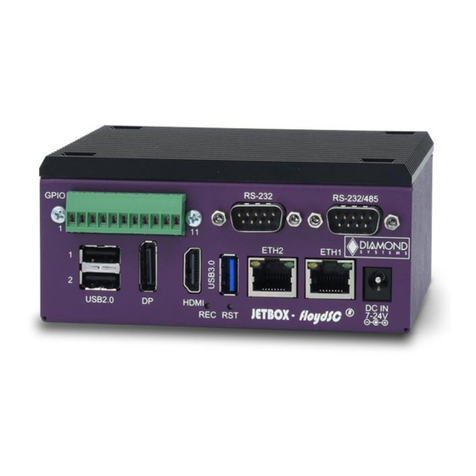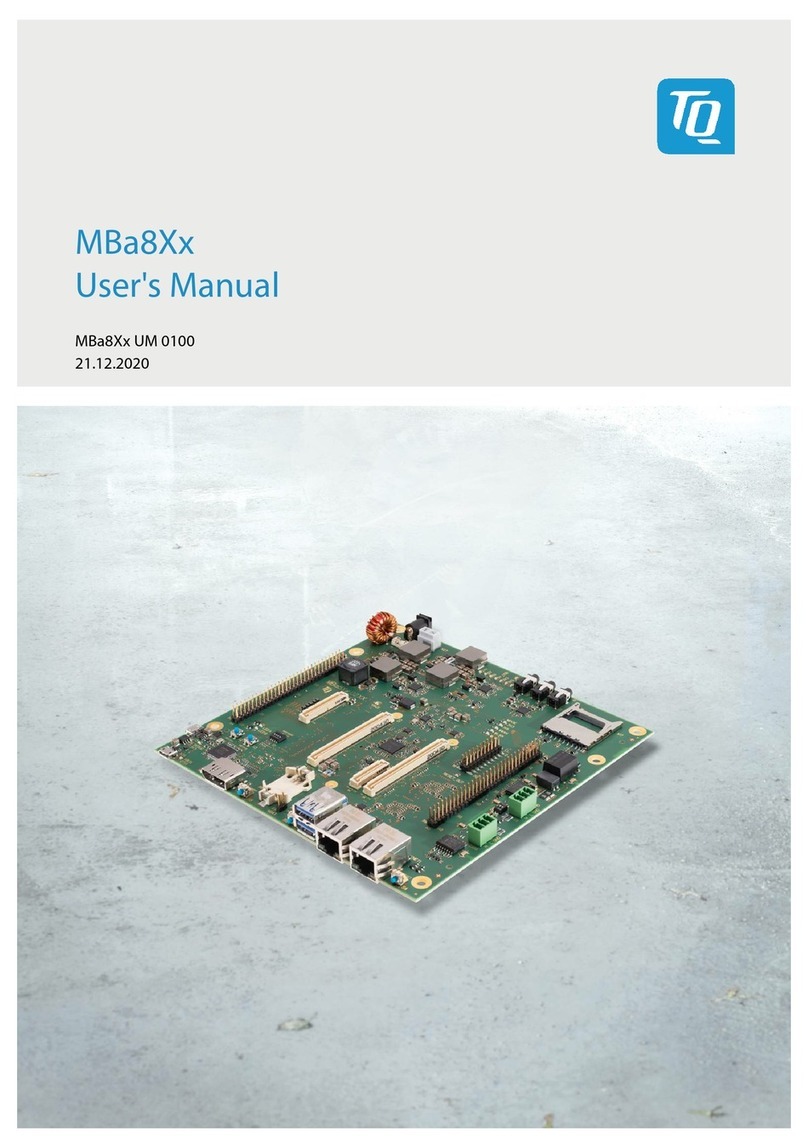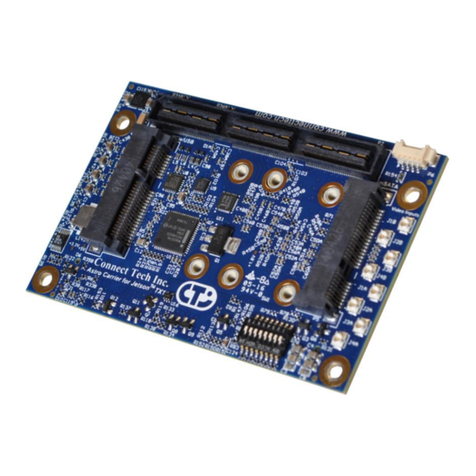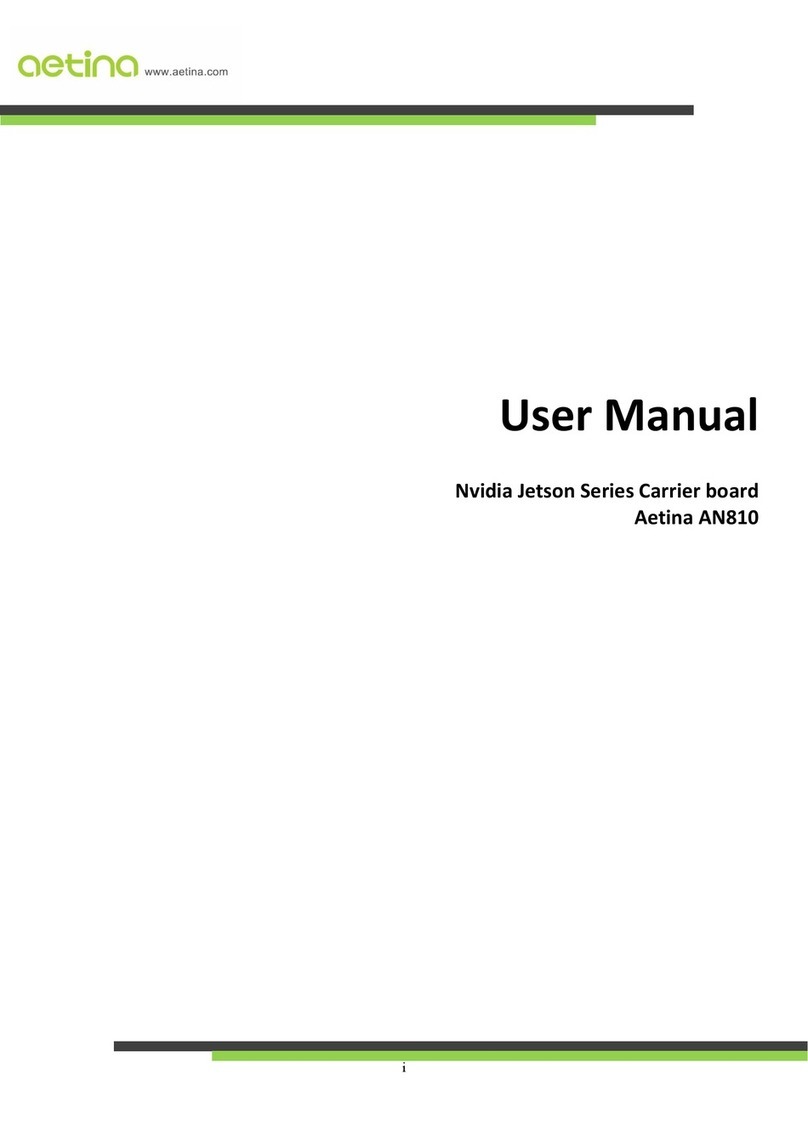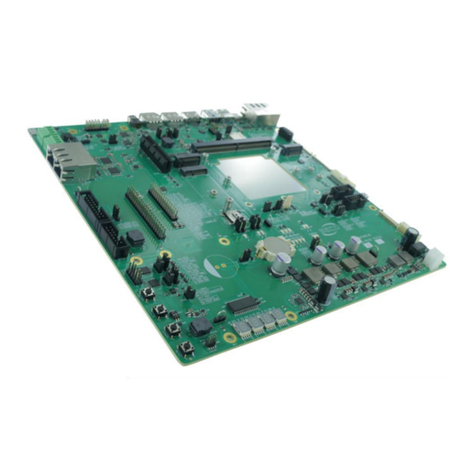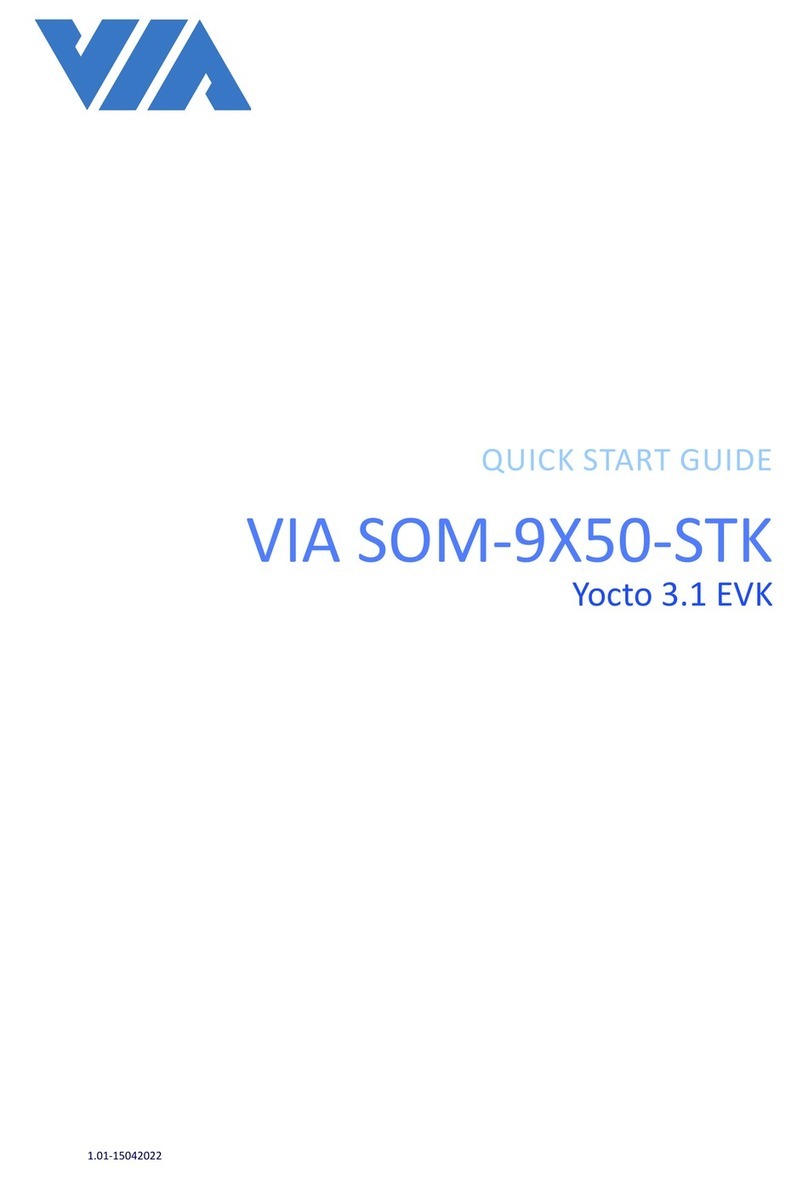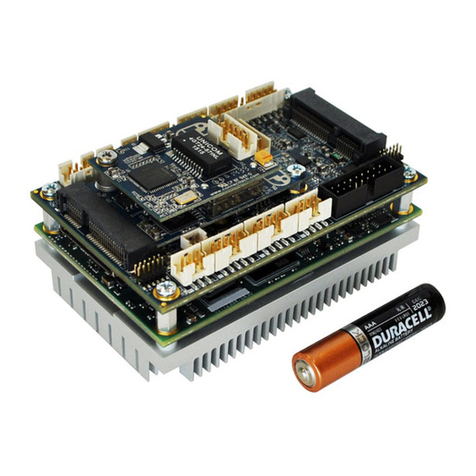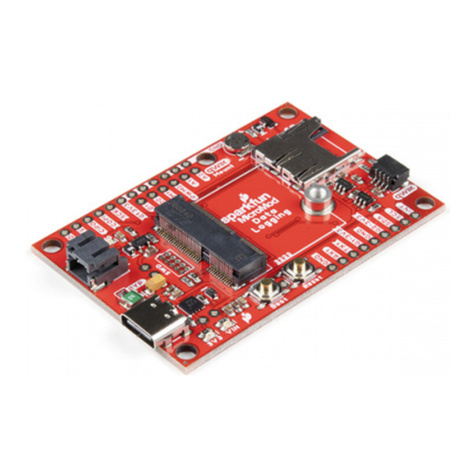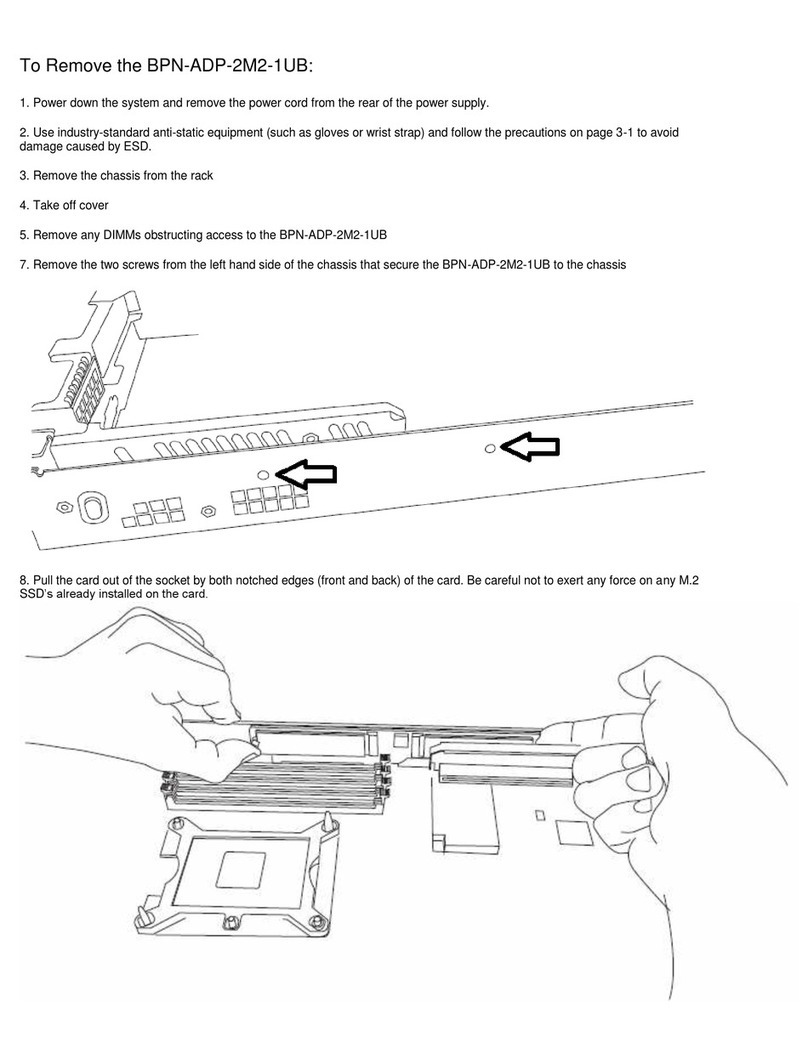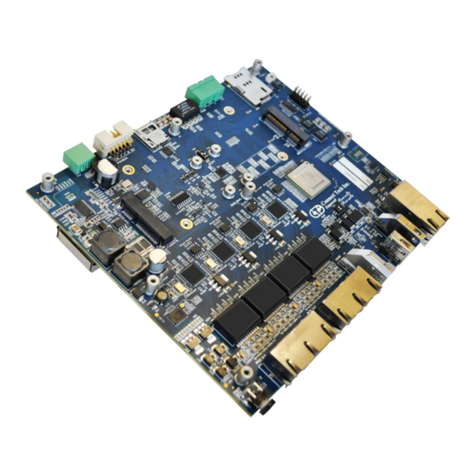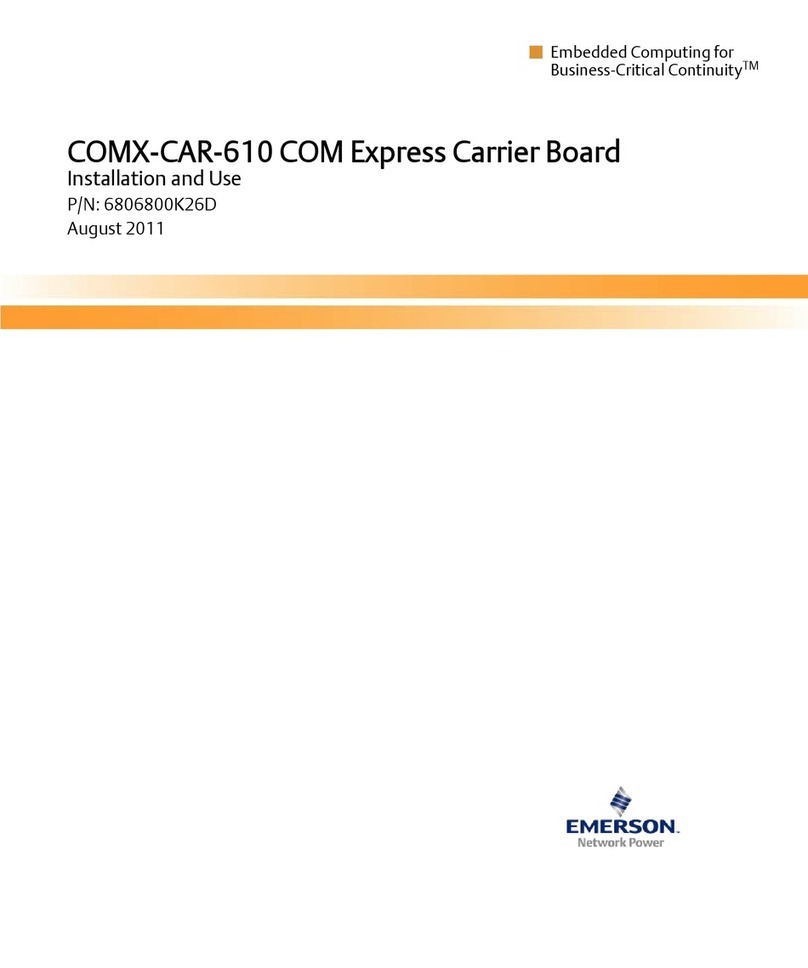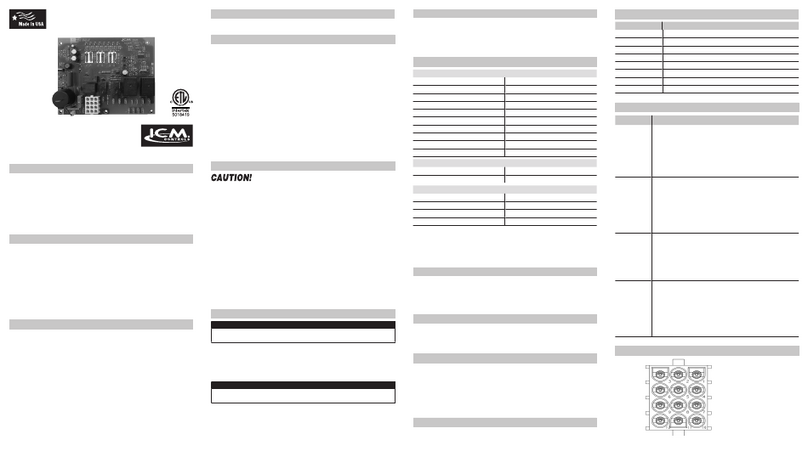Acromag AVME9675 Series User manual

Artisan Technology Group is your source for quality
new and certied-used/pre-owned equipment
• FAST SHIPPING AND
DELIVERY
• TENS OF THOUSANDS OF
IN-STOCK ITEMS
• EQUIPMENT DEMOS
• HUNDREDS OF
MANUFACTURERS
SUPPORTED
• LEASING/MONTHLY
RENTALS
• ITAR CERTIFIED
SECURE ASSET SOLUTIONS
SERVICE CENTER REPAIRS
Experienced engineers and technicians on staff
at our full-service, in-house repair center
WE BUY USED EQUIPMENT
Sell your excess, underutilized, and idle used equipment
We also offer credit for buy-backs and trade-ins
www.artisantg.com/WeBuyEquipment
REMOTE INSPECTION
Remotely inspect equipment before purchasing with
our interactive website at www.instraview.com
LOOKING FOR MORE INFORMATION?
Visit us on the web at www.artisantg.com for more
information on price quotations, drivers, technical
specications, manuals, and documentation
Contact us: (888) 88-SOURCE | sales@artisantg.com | www.artisantg.com
SM
View
Instra

Series AVME9675 Industrial I/O Pack
VME64x Bus 6U Non-Intelligent Carrier Board
USER’S MANUAL
ACROMAG INCORPORATED
30765 South Wixom Road
P.O. BOX 437
Wixom, MI 48393-7037 U.S.A.
Tel: (248) 624-1541
Fax: (248) 624-9234
Copyright 2000, Acromag, Inc., Printed in the USA.
Data and specifications are subject to change without notice.
8500-628-C01D003
Artisan Technology Group - Quality Instrumentation ... Guaranteed | (888) 88-SOURCE | www.artisantg.com

INDUSTRIAL I/O PACK SERIES AVME9675 VME64x 6U CARRIER BOARDS
___________________________________________________________________________________________
- 2 -
The information contained in this manual is subject to change
without notice. Acromag, Inc. makes no warranty of any kind with
regard to this material, including, but not limited to, the implied
warranties of merchantability and fitness for a particular purpose.
Further, Acromag, Inc. assumes no responsibility for any errors that
mayappear in this manual and makes no commitment to update, or
keep current, the information contained in this manual. No part of
this manual may be copied or reproduced in anyform, without the
prior written consent of Acromag, Inc.
Table of Contents Page
1.0 GENERAL INFORMATION............................................... 2
KEY AVME9675 FEATURES............................................ 2
VME64x INTERFACE FEATURES................................... 3
SIGNAL INTERFACE PRODUCTS.................................. 3
INDUSTRIAL I/O PACK SOFTWARE LIBRARY.............. 4
2.0 PREPARATION FOR USE................................................ 4
UNPACKING AND INSPECTION..................................... 4
CARD CAGE CONSIDERATIONS................................... 4
BOARD CONFIGURATION.............................................. 4
VME64x INTERFACE CONFIGURATION....................... 4
Address Decode Configuration…………........................ 4
VME64x Address Modifiers............................................ 5
Interrupt Configuration.................................................... 5
CONNECTORS................................................................ 5
Carrier Field I/O Connectors (IP modules A-D).............. 5
IP Field I/O Connectors (IP modules A-D)..................... 5
IP Logic Interface Connectors (IP modules A-D)........... 5
VME64x Connections..................................................... 6
POWER-UP TIMING AND LOADING.............................. 7
DATA TRANSFER TIMING.............................................. 7
FIELD GROUNDING CONSIDERATIONS....................... 7
3.0 PROGRAMMING INFORMATION.................................... 7
GEOGRAPHICAL ADDRESSING..................................... 7
CONFIGURATION ROM (CR) ASSIGNMENTS.............. 8
CONTROL/STATUS REGISTER (CSR) ASSIGN………. 8
AVME9675 CARRIER & IP MODULE REGISTERS…….. 9
Identification ROM…...................................................... 11
Carrier Board Status Register........................................ 11
Interrupt Level Register.................................................. 11
IP Error Register............................................................ 12
IP Memory Enable Register............................................ 12
IP Memory Base Address & Size Registers................... 12
IP Interrupt Enable Register........................................... 13
IP Interrupt Pending Register......................................... 13
IP Interrupt Clear Register.............................................. 13
GENERAL PROGRAMMING CONSIDERATIONS.......... 13
Board Diagnostics.......................................................... 13
GENERATING INTERRUPTS.......................................... 13
Interrupt Configuration Example.................................... 13
Sequence of Events for an Interrupt.............................. 14
4.0 THEORY OF OPERATION............................................... 14
CARRIER BOARD OVERVIEW....................................... 14
VME64x Interface........................................................... 14
Carrier Board Registers.................................................. 15
IP Logic Interface........................................................... 15
Carrier Board Clock Circuitry.......................................... 15
IP Read and Write Cycle Timing.................................... 15
VME64x Interrupter........................................................ 15
Power Failure Monitor..................................................... 16
Access LEDs and Pulse Stretcher Circuitry................... 16
Power Supply Filters...................................................... 16
Power Supply Fuses...................................................... 16
5.0 SERVICE AND REPAIR.................................................... 16
SERVICE AND REPAIR ASSISTANCE........................... 16
PRELIMINARY SERVICE PROCEDURE......................... 16
6.0 SPECIFICATIONS............................................................. 16
PHYSICAL......................................................................... 16
VME64x COMPLIANCE.................................................... 17
INDUSTRIAL I/O PACK COMPLIANCE........................... 17
ENVIRONMENTAL........................................................... 18
APPENDIX......................................................................... 19
CABLE, SCSI-2 to Flat Ribbon: MODEL 5028-187…….. 19
TERMINATION PANEL: MODEL 5025-552..................... 19
VME64x TRANSITION MODULE: MODEL TRANS-200.. 19
DRAWINGS Page
4501-800 AVME9675 IP LOCATIONS.......……………... 20
4501-801 MECHANICAL ASSEMBLY DRAWING...…... 21
4501-802 AVME9675 BLOCK DIAGRAM........................ 22
4501-758 CABLE, SCSI-2 to Flat Ribbon 5028-187......... 23
4501-464 TERMINATION PANEL 5025-552................... 24
4501-760 VME64x TRANSITION MOD., TRANS-200.. 25
IMPORTANT SAFETY CONSIDERATIONS
It is very important for the user to consider the possible adverse
effects of power, wiring, component, sensor, or software failures in
designing any type of control or monitoring system. This is
especially important where economic property loss or human life is
involved. It is important that the user employ satisfactory overall
system design. It is agreed between the Buyer and Acromag, that
this is the Buyer's responsibility.
1.0 GENERAL INFORMATION
The AVME9675 VME64x bus card is a carrier for the Industrial
I/O Pack (IP) mezzanine board field I/O modules. The Industrial I/O
Packs field I/O exits the carrier via the rear panel per the VME64
Extensions (ANSI/VITA 1.1-1997). The carrier boards facilitate a
modular approach to system assembly, since each carrier can be
populated with any combination of analog input/output and digital
input/output IP modules. Thus, the user can create a board which is
customized to the application which saves money and space - a
single carrier board populated with IP modules may replace several
dedicated function VMEbus boards. The AVME9675 non-intelligent
carrier boards provide impressive functionality at low cost.
Model is available in one standard VME64x bus 6U size, with
support for up to four IP modules.
MODEL VME64x
Board Size Supported
IP Slots Operating
Temperature
Range
AVME9675-4 6U 4 (A,B,C,D) 0 to +70 °C
AMVE9675-4E 6U 4 (A,B,C,D) -40 to +85 °C
AVME9675-2 6U 2 (A,B) 0 to +70 °C
AVME9675-2E 6U 2 (A,B) -40 to +85 °C
KEY AVME9675 FEATURES
•Supports Four IP Modules - Provides an electrical and
mechanical interface for up to four industry standard IP
Artisan Technology Group - Quality Instrumentation ... Guaranteed | (888) 88-SOURCE | www.artisantg.com

INDUSTRIAL I/O PACK SERIES AVME9675 VME64x 6U CARRIER BOARD
___________________________________________________________________________________________
- 3 -
modules. IP Modules are available from Acromag and other
vendors in a wide variety of Input/Output configurations to meet
the needs of varied applications.
•Provides Full IP Data Access - Supports accesses to IP
input/output, memory, identification data, and interrupt spaces.
•Full IP Register Access - Makes maximum use of logically
organized programmable registers on the carrier boards to
provide for easy configuration and control of IP modules.
•VME64 & VME64x CR/CSR Space – Configuration ROM /
Control & Status Register (CR/CSR) space provides additional
carrier board identification & programming capabilities. These
include software selection of the base address and address
modifier of the carrier card in the short I/O space.
•VME64x Geographical Addressing – Supports the six
Geographical Addressing signals provided by VME64x
backplanes. These signals control the base address of the
CR/CSR space of each installed carrier. This provides
unambiguous identification of each carrier’s location within the
VME64x chassis.
•No Hardware Jumpers or Switches – The board is fully
configurable via control registers.
•LED Indicators Simplify Debugging - Front panel LED's are
dedicated to each IP module to give a visual indication of
successful IP accesses.
•Rear Backplane Connectors Access I/O - Rear backplane
connector P2 & P0 access to field I/O signals mapped per the
VME64x IP I/O (ANSI/VITA 4.1-1996) specification.
•Memory Space Access Support - IP memory space
accesses are supported and software configurable from
1Mbyte to 8Mbytes in the VME64x bus standard address
space.
•Supports Two Interrupt Channels per IP - Up to two
interrupt requests are supported for each IP. The VME64x bus
interrupt level is software programmable. Additional registers
are associated with each interrupt request for control and
status monitoring.
•Interrupt Priority Control - Interrupts use a proirity shifting
scheme based on the last interrupt serviced. This prevents the
continuous interrupts of one IP module interrupt request from
blocking the interrupts of other IP modules.
•Supervisory Circuit for Reset Generation - A
microprocessor supervisor circuit provides power-on, power-
off, and low power detection reset signals to the IP modules per
the IP specification.
•Individually Filtered Power - Filtered +5V, +12V, and -12V
DC power is provided to the IP modules via passive filters
present on each supply line serving each IP. This provides
optimum filtering and isolation between the IP modules and the
carrier board and allows analog signals to be accurately
measured or reproduced on IP modules without signal
degradation from the carrier board logic signal noise.
•ESD Strip - The AVME9675 board has been designed to
provide electrostatic discharge (ESD) capability by using an
ESD strip on the board per ANSI/VITA 1.1-1997 and
IEEE1101.10.
•Injector/Ejector Handles - The AVME9675 uses modern
injector/ejector handles, which push the board into the rack
during installation and pull the board out of the rack for removal
or replacement. These handles are needed to give you
leverage to install and remove the board.
VME64x bus INTERFACE FEATURES
•Slave Module-
CR/CSR Registers A24, D16/D08(O)
Carrier Register Short I/O Access A16, D16/D08(O)
IP Module ID Space A16, D16/D08(O)
IP Module I/O Space A16, D16/D08(EO)
IP Module Memory Space A24, D16/D08(EO)
•Supports Short I/O Address Modifiers - Supports short I/O
(A16) address modifiers 29H, 2DH (H = Hex). Short I/O space
is used for carrier registers and IP module I/O and ID spaces.
The carrier board base addresss and short I/O address
modifier is set within the Function 0 Address DEcoder
CompaRe register (ADER) in CR/CSR space and decoded on
1K byte boundaries.
•Supports CR/CSR Space Address Modifier – Supports
address modifier 2FH (H = Hex). CR/CSR space is used to
establish initial module communication, identification, location
(via geographic address), module base address, address
modifier and additional configuration parameters.
•Supports Standard I/O Address Modifiers - Supports
standard (A24) address modifiers 39H, 3DH (H = Hex).
Standard address space is used when an IP supports memory
space. The carrier board is configured using programmable
registers to set the IP starting address and size (1Mbyte to
8Mbytes).
•Supports Read-Modify-Write Cycles - Carrier board
supports VME64x bus read-modify-write cycles.
•Interrupt Support - I(1-7) interrupter D16/D08 (O). Up to two
interrupt requests are supported for each IP module. The
VME64x bus interrupt level is software programmable. Carrier
board software programmable registers are utilized as interrupt
request control and status monitors. Interrupt release
mechanism is Release On Register Access (RORA) type.
SIGNAL INTERFACE PRODUCTS
(See Appendixfor more information on compatible products)
This IP carrier board will mate directly toall industry standard 8
MHz IP modules. Acromag provides the following interface products
(all connections to field signals are made through the carrier board
and transition module which passes them to the individual IP
modules):
Cables:
Model 5028-187 (SCSI-2 to Flat Ribbon Cable, Shielded): A
round 50 conductor shielded cable with a male SCSI-2
connector at one end and a flat female ribbon connector at the
other end. The cable is used for connecting AVME9670 or
AVME9675 with the TRANS-200, or other compatible carrier
boards, to Model 5025-552 termination panels.
Termination Panel:
Model 5025-552: DIN-rail mountable panel provides 50 screw
terminals for universal field I/O termination. Connects to
Acromag AVME9670 or AVME9675 with the TRANS-200, or
other compatible carrier boards, via SCSI-2 to Flat Ribbon
Cable, Shielded (Model 5028-187).
VME64x Transition Module :
Model TRANS-200: This module plugs into the rear backplane
directly behind the carrier board. The field I/O connections are
made through the backplane to P0 (AVME9670 & AVME9675-4)
and P2 (AVME9670, AVME9675-2 & AVME9675-4) connectors of
the carrier board and then routed to four (two AVME9675-2) SCSI-2
connectors on the transition module (marked IP module slots “A
through D”) or (“A through B” for AVME9675-2) for rear exit from the
card cage. It is availablefor use in VME64xbus card cages which
provide rear exit for I/O connections via transition modules (transition
modules can only be used in card cages specifically designed for
them). It is a double-height (6U), single-slot module with front panel
Artisan Technology Group - Quality Instrumentation ... Guaranteed | (888) 88-SOURCE | www.artisantg.com

INDUSTRIAL I/O PACK SERIES AVME9675 VME64x 6U CARRIER BOARD
___________________________________________________________________________________________
- 4 -
hardware adhering to the VME64x bus mechanical dimensions and
IEEE Standard (1101.11-1998), with a printed circuit board depth of
80mm, which is a standard transition module depth. The transition
module connects to Acromag Termination Panel (Model 5025-552)
using SCSI-2 to Flat Ribbon Cable, Shielded (Model 5028-187) to
the rear of the card cage, and to AVME9670, AVME9675-2 &
AVME9675-4 boards within the card cage.
INDUSTRIAL I/O PACK SOFTWARE LIBRARY
Acromag provides an Industrial I/O Pack Software Library diskette
(Model IPSW-LIB-M03-1.44MB, MSDOS format) to simplify
communication with Acromag IP modules. All functions are written
in the “C” programming language and can be linked to your
application. Refer to the “README.TXT” file in the root directory on
the diskette for more details and the “info9675.TXT” files of the
“AVME9675” subdirectories that correspond to your carrier model.
2.0 PREPARATION FOR USE
UNPACKING AND INSPECTION
Upon receipt of this product, inspect the shipping carton for
evidence of mishandling during transit. If the shipping carton is
badlydamaged or water stained, request that the carrier's agent be
present when the carton is opened. If the carrier's agent is absent
when the carton is opened and the contents of the carton are
damaged, keep the carton and packing material for the agent's
inspection.
For repairs to a product damaged in shipment, refer to the
Acromag Service Policy to obtain return instructions. It is
suggested that salvageable shipping cartons and packing material
be saved for future use in the event the product must be shipped.
This board is physically protected
with packing material and electrically
protected with an anti static bag
during shipment. It is recommended
that the board be visually inspected
for evidence of mishandling prior to
applying power.
The board utilizes static sensitive
components and should only be
handled at a static-safe workstation.
CARD CAGE CONSIDERATIONS
Refer to the specifications for loading and power requirements.
Be sure that the system power supplies are able to accommodate
the power requirements of the carrier board, plus the installed IP
modules, within the voltage tolerances specified.
IMPORTANT: Adequate air circulation must be provided to prevent
a temperature rise above the maximum operating temperature.
The dense packing of the IP modules to the carrier board
restricts air flow within the card cage and is cause for concern.
Adequate air circulation must be provided to prevent a temperature
rise above the maximum operating temperature and to prolong the
life of the electronics. If the installation is in an industrial
environment and the board is exposed to environmental air, careful
consideration should be given to air-filtering.
BOARD CONFIGURATION
The carrier board may be configured for different applications.
Configuration options will be discussed in the following Sections.
The IP module positions are shown in Drawing 4501-800. Power
should be removed from the board when installing IP modules,
cables, termination panels, and field wiring. Refer to Mechanical
Assembly Drawing 4501-801 and your IP module documentation for
specific configuration and assembly instructions.
VME64x INTERFACE CONFIGURATION
The carrier board is shipped from the factory configured as
follows:
•Carrier board will respond to address modifier 2FH for
CR/CSR standard (A24) address space access. Base
address of the CR/CSR space is located in the CR/CSR Base
Address Register (BAR). Geographic addressing (per the
VME64x specification) is used to set the CR/CSR base
address and also to determine the active CR/CSR card
locations within the VME64x chassis.
•Carrier board must be programmed with the Short I/O base
address and address modifier within the Function 0 Address
DEcoder CompaRe (ADER) Register in CR/CSR space to
define the base address of the AVME9675 carrier & IP module
registers.
•Programmable Bit Set Register in the CR/CSR defaults to
Short I/O accesses disabled. Once enabled via the Bit Set
Register the board will respond to address modifier 29H or
2DH, as programmed in theADER. Registers on the carrier
board plus the I/O and ID spaces on anyinstalled IP modules
will then become accessible.
•Programmable software registers default to IP memory space
(VME64x bus standard address space) accesses disabled.
•Programmable software registers default to IP interrupt
requests-disabled and VME64x bus interrupt level-none.
Address Decode Configuration
There are no address jumpers or switches on this board. All
configuration takes place via control registers. Initial communication
with the carrier must be made to the CR/CSR space using
geographic addressing per the VME64x specification. The VME64x
backplane applies six geographic address signal lines to the P1
connector as listed in Table 2.1:
Artisan Technology Group - Quality Instrumentation ... Guaranteed | (888) 88-SOURCE | www.artisantg.com

INDUSTRIAL I/O PACK SERIES AVME9675 VME64x 6U CARRIER BOARD
___________________________________________________________________________________________
- 5 -
Table 2.1: Geographical Address Pin Assignments
Slot
No. GAP*
Pin GA4*
Pin GA3*
Pin GA2*
Pin GA1*
Pin GA0*
Pin
1 Open Open Open Open Open GND
2 Open Open Open Open GND Open
3 GND Open Open Open GND GND
4 Open Open Open GND Open Open
5 GND Open Open GND Open GND
6GND Open Open GND GND Open
7Open Open Open GND GND GND
8Open Open GND Open Open Open
9 GND Open GND Open Open GND
10 GND Open GND Open GND Open
11 Open Open GND Open GND GND
12 GND Open GND GND Open Open
13 Open Open GND GND Open GND
14 Open Open GND GND GND Open
15 GND Open GND GND GND GND
16 Open GND Open Open Open Open
17 GND GND Open Open Open GND
18 GND GND Open Open GND Open
19 Open GND Open Open GND GND
20 GND GND Open GND Open Open
21 Open GND Open GND Open GND
The AVME9675 board has pull-up resistors tied to each of the
six geographic address inputs, so that their state (Open = “high” or
GND = “low”) can be interpreted by logic on the carrier board. This
logic uses the geographic addressing inputs to encode the base
address of the CR/CSR space into the CR/CSR Base Address
Register (BAR). The host computer can locate the AVME9675 by
scanning the A24 CR/CSR space using address modifier 2FH (refer
to section 3 for CR/CSR space programming details).
Once located, additional characteristics of the AVME9675 may
be read from the Configuration ROM (CR) portion of the space.
Following power up, accesses to the card’s Short I/O (A16) space
are disabled. The base address of the carrier in the Short I/O space
and the desired address modifier must be programmed using the
Function 0 Address DEcoder CompaRe (ADER) Register in the
Control/Status Register (CSR) portion of the CR/CSR space. Then,
accesses to the Short I/O space can be enabled by writing to the Bit
Set Register in theCSR. Each carrier board implements a 1K byte
block of addresses in the Short I/O space.
•Consult your host CPU manual for detailed information about
addressing the VME64x bus short I/O (A16, 16-bit) space. In
manycases, CPU's utilizing 24-bit addressing will start the 16-
bit address at FF0000 (Hex), and 32-bit CPU's at FFFF0000
(Hex).
VME64x bus Address Modifiers
No hardware jumper configuration is needed. The carrier board
initially responds to address modifier 2FH in the standard (A24)
CR/CSR space.
Following configuration within the CR/CSR space the carrier
board will respond to either address modifier 29H or 2DH in the
VME64xbus Short (A16) I/O space. This means that both short
supervisory and short non-privileged accesses are supported.
The carrier board will also respond to both address modifiers
39H and 3DH in the VME64x bus standard (A24) address space,
when standard address space accesses to IP memory are enabled
via programmable registers on the carrier board (refer to Section 3
for programming details).
Interrupt Configuration
No hardware jumper configuration is required. All interrupt
enabling, status, and VME64x bus interrupt level selections are
configured via programmable registers on the carrier board (see
Section 3 for programming details). The carrier board passes
interrupt requests from the IP modules to the VME64x bus -- It does
not originate interrupt requests. Refer to the IP modules for their
specific configuration requirements.
CONNECTORS
Carrier Field I/O Connectors (IP modules A through D)
Field I/O connections are made through the rear via transition
module (TRANS-200) connectors A-D for IP modules in positions A-
D, respectively. IP module assignment is marked on the transition
module for easy identification (see IP location drawing 4501-800 for
physical locations of the IP modules). SCSI-2 Round cable
assemblies and Acromag termination panels (or user defined
terminations) can be quickly mated to the transition module
connectors. Pin assignments are defined by the IP I/O Mapping to
VME64x Standard (ANSI/VITA 4.1-1996).
Connectors A-D are 50-pin SCSI-2 right angle (female)
connectors (AMP). Connectors are high-density, and there is one
connector for each IP module marked with A-D on the transition
module panel. These connectors include spring latch hardware and
30 microns of gold in the mating area for excellent connection.
The TRANS-200 was originallydesigned for use with the
AVME9670 product which supports four IP modules A-D. It also
maybe used for the four IP slot AVME9675-4 or the two slot
AVME9675-2.
IP Field I/O Connectors (IP modules A through D)
The field side connectors of IP modules A-D mate to connectors
P3, P5, P7 and P9, respectively, on thecarrier board. IP location is
silk-screened on the board for easy identification. Field and logic
side connectors are keyed to avoid incorrect assembly.
P3, P5, P7, and P9 are 50-pin male plug header connectors.
These AMP 173280-3 connectors mate to AMP 173279-3
connectors (or similar) on the IP modules. This provides excellent
connection integrity and utilizes gold plating in the mating area.
Threaded metric M2 screws and spacers (supplied with Acromag IP
modules) provide additional stability for harsh environments (see
Drawing 4501-801 for assembly details).
Pin assignments for these connectors are made by the specific
IP model used and correspond identically to the pin numbers of the
transition module panel connectors.
IP Logic Interface Connectors (IP modules A through D)
The logic interface sides of IP modules A-D mate to connectors
P4, P6, P8, and P10, respectively, on the carrier board. IP location
is silk-screened on the board for easy identification. Field and logic
side connectors are keyed to avoid incorrect assembly.
P4, P6, P8, and P10 are 50-pin male plug header connectors.
These AMP 173280-3 connectors mate to AMP 173279-3
connectors (or similar) on the IP modules. This provides excellent
connection integrity and utilizes gold plating in the mating area.
Threaded metric M2 screws and spacers (supplied with Acromag IP
modules) provide additional stability for harsh environments (see
Drawing 4501-801 for assembly details).
Artisan Technology Group - Quality Instrumentation ... Guaranteed | (888) 88-SOURCE | www.artisantg.com

INDUSTRIAL I/O PACK SERIES AVME9675 VME64x 6U CARRIER BOARD
___________________________________________________________________________________________
- 6 -
Pin assignments for these connectors are defined by the IP
module specification and are shown in Table 2.2:
Table 2.2: Standard IP Logic Interface Connections (P4,6,8,10)
Pin Description Number Pin Description Number
GND 1 GND 26
CLK2+5V27
Reset* 3 R/W* 28
D00 4 IDSEL* 29
D01 5 DMAReq0* 30
D02 6 MEMSEL* 31
D03 7 DMAReq1* 32
D04 8 IntSel* 33
D05 9 DMAck0* 34
D06 10 IOSEL* 35
D07 11 RESERVED 36
D08 12 A1 37
D09 13 DMAEnd* 38
D10 14 A2 39
D11 15 ERROR* 40
D12 16 A3 41
D13 17 INTReq0* 42
D14 18 A4 43
D15 19 INTReq1* 44
BS0* 20 A5 45
BS1* 21 STROBE* 46
-12V 22 A6 47
+12V 23 ACK* 48
+5V 24 RESERVED 49
GND 25 GND 50
Asterisk (*) is used to indicate an active-low signal.
BOLD ITALIC Logic Lines are NOT USED by the carrier board.
VME64x bus Connections for P1
Table 2.3 indicates the pin assignments for the VME64x bus
signals at the P1 connector. The P1 connector is the upper rear
connector on the AVME9675 board, as viewed from the front. The
connector consists of 32 rows of five pins labeled A, B, C, D and Z.
Pin Z1 is located at the upper right hand corner of the connector if
the board is viewed from the front component side.
Refer to the VME64x bus specification for additional information
on the VME64x bus signals.
TABLE 2.3: VME64x bus P1 CONNECTIONS
Pin Row Z Row A Row B Row C Row D
1MPR D00 BBSY* D08 VPCφ
2GND D01 BCLR* D09 GNDφ
3MCLK D02 ACFAIL* D10 +V1
4GND D03 BG0IN* D11 +V2
5MSD D04 BG0OUT* D12 RsvU
6GND D05 BG1IN* D13 -V1
7MMD D06 BG1OUT* D14 -V2
8GND D07 BG2IN* D15 RsvU
9MCTL GND BG2OUT* GND GAP*
10 GND SYSCLK BG3IN* SYSFAIL* GA0*
11 RESP* GND BG3OUT* BERR* GA1*
12 GND DS1* BR0* SYSRESET* +3.3V
13 RsvBus DS0* BR1* LWORD* GA2*
14 GND WRITE* BR2* AM5 +3.3V
15 RsvBus GND BR3* A23 GA3*
16 GND DTACK* AM0 A22 +3.3V
17 RsvBus GND AM1 A21 GA4*
18 GND AS* AM2 A20 +3.3V
19 RsvBus GND AM3 A19 RsvBus
20 GND IACK* GND A18 +3.3V
21 RsvBus IACKIN* SERA A17 RsvBus
22 GND IACKOUT* SERB A16 +3.3V
23 RsvBus AM4 GND A15 RsvBus
24 GND A07 IRQ7* A14 +3.3V
25 RsvBus A06 IRQ6* A13 RsvBus
26 GND A05 IRQ5* A12 +3.3V
27 RsvBus A04 IRQ4* A11 LI/I*
28 GND A03 IRQ3* A10 +3.3V
29 RsvBus A02 IRQ2* A09 LI\O*
30 GND A01 IRQ1* A08 +3.3V
31 RsvBus -12V +5VSTDBY +12V GNDφ
32 GND +5V +5V +5V VPCφ
Asterisk (*) is used to indicate an active-low signal.
Shaded area are pins defined under the VME64 bus specification.
BOLD ITALIC Logic Lines are NOT USED by the carrier board.
(φ) = Elongated (mate first, break last) connector contact.
VME64x bus Connections for P2
Table 2.4 indicates the pin assignments for the VME64x bus
signals at the P2 connector. The P2 connector is the lower rear
connector on the AVME9675 board, as viewed from the front. The
connector consists of 32 rows of five pins labeled A, B, C, D and Z.
Pin Z32 is located at the lower right hand corner of the connector if
the board is viewed from the front component side.
TABLE 2.4: VME64x bus P2 CONNECTIONS
Pin Row Z Row A Row B Row C Row D
1C46 B41 Not Used B42 C47φ
2GND B43 Not Used B44 C48φ
3C49 B45 Not Used B46 C50
4GND B47 Not Used B48 B1
5B2 B49 Not Used B50 B3
6GND A1 Not Used A2 B4
7B5 A3 Not Used A4 B6
8GND A5 Not Used A6 B7
9B8 A7 Not Used A8 B9
10 GND A9 Not Used A10 B10
11 B11 A11 Not Used A12 B12
12 GND A13 Not Used A14 B13
13 B14 A15 Not Used A16 B15
14 GND A17 Not Used A18 B16
15 B17 A19 Not Used A20 B18
16 GND A21 Not Used A22 B19
17 B20 A23 Not Used A24 B21
18 GND A25 Not Used A26 B22
19 B23 A27 Not Used A28 B24
20 GND A29 Not Used A30 B25
21 B26 A31 Not Used A32 B27
22 GND A33 Not Used A34 B28
23 B29 A35 Not Used A36 B30
24 GND A37 Not Used A38 B31
25 B32 A39 Not Used A40 B33
26 GND A41 Not Used A42 B34
27 B35 A43 Not Used A44 B36
28 GND A45 Not Used A46 B37
29 B38 A47 Not Used A48 B39
30 GND A49 Not Used A50 B40
31 Not Used Not Used Not Used Not Used Not Used
φ
32 GND Not Used Not Used Not Used Not Usedφ
Artisan Technology Group - Quality Instrumentation ... Guaranteed | (888) 88-SOURCE | www.artisantg.com

INDUSTRIAL I/O PACK SERIES AVME9675 VME64x 6U CARRIER BOARD
___________________________________________________________________________________________
- 7 -
Note: The letter in front of the number indentifies the IP Module
Slot. The number indentifies the I/O pin number of that IP
Module.
Example: A46 A = IP Module in Slot “A”
46 = I/O Pin number “46”
(This pin on the IP Module connects to P2, Pin 28, Row C.)
Shaded area are pins defined under the VME64x bus specification.
BOLD ITALIC Logic Lines are NOT USED by the carrier board.
(φ) = Elongated (mate first, break last) connector contact.
The I/O signals for the P2 connector are mapped per the IP
Module I/O to VME64x bus Standard (ANSI/VITA 4.1-1996). Refer
to this standard for additional information on the VME64x bus
signals.
VME64x bus Connections for P0
Table 2.5 lists the pin assignments for the VME64x bus signals
at the P0 connector. The P0 connector is the center connector on
the AVME9675 board, as viewed from the front. The connector
consists of 6 rows of 19 pins labeled A, B, C, D, E, and F. Pin A1
is located at the upper right hand corner of the connector near the
center of the board, viewed from the front component side.
The I/O signals for the P0 connector are mapped per the IP
Module I/O to VME64Xbus Standard (ANSI/VITA 4.1-1996). Refer
to this standard for additional information on the VME64x bus
signals.
TABLE 2.5: VME64x bus P0 CONNECTIONS
Pin Row A Row B Row C Row D Row E Row F
1D1D2D3D4D5GND
2D6D7D8D9D10NP
3 D11 D12 D13 D14 D15 GND
4 D16 D17 D18 D19 D20 NP
5 D21 D22 D23 D24 D25 GND
6 D26 D27 D28 D29 D30 NP
7 D31 D32 D33 D34 D35 GND
8 D36 D37 D38 D39 D40 NP
9 D41 D42 D43 D44 D45 GND
10 D46 D47 D48 D49 D50 NP
11 C1 C2 C3 C4 C5 GND
12 C6 C7 C8 C9 C10 NP
13 C11 C12 C13 C14 C15 GND
14 C16 C17 C18 C19 C20 NP
15 C21 C22 C23 C24 C25 GND
16 C26 C27 C28 C29 C30 NP
17 C31 C32 C33 C34 C35 GND
18 C36 C37 C38 C39 C40 NP
19 C41 C42 C43 C44 C45 GND
Note: The letter in front of the number indentifies the IP Module
Slot. The number indentifies the I/O pin number of that IP
Module.
Example: D1 D = IP Module in Slot “D”
1 = I/O Pin number “1”
(This pin on the IP Module connects to P0, Pin 1, Row A.)
(NP) = No Pin for PO connector (Row F is for upper ground shield).
•The P0 connector will not be present on AVME9675-2 models.
POWER-UP TIMING AND LOADING
The AVME9675 board uses a Field Programmable Gate-Array
(FPGA) to handle the bus interface and control logic timing. Upon
power-up, the FPGA automatically clocks in configuration vectors
from a local PROM to initialize the logic circuitry for normal
operation. This time is measured as the first 145mS (typical) after
the +5 Volt supply rises to +2.5 Volts at power-up. The VME64x
bus specification requires that the bus master drive the system reset
for the first 200mS after power-up, thus inhibiting any data transfers
from taking place.
IP control registers are also reset following a power-up
sequence, disabling interrupts, etc. (see Section 3 for details).
DATA TRANSFER TIMING
VME64x bus data transfer time is measured from the falling
edge of DSx* to the falling edge of DTACK* during a normal data
transfer cycle. Typical transfer times are given in the following table.
Register Data Transfer Time
All Carrier Registers 450 nS, Typical.
IP Registers 450 nS, Typical, If No Wait States*
* See IP module specifications for information on wait states. IP
module register access time will increase by the number of wait
states multiplied by 125nS (the period of the 8 MHz clock).
FIELD GROUNDING CONSIDERATIONS
Carrier boards are designed with passive filters on each supply
line to each IP module. This provides maximum filtering and signal
isolation between the IP modules and the carrier board. However,
the boards are considered non-isolated, since there is electrical
continuity between the VME64x bus and the IP grounds. Therefore,
unless isolation is provided on the IP module itself, the field I/O
connections are not isolated from the VME64x bus. Care should be
taken in designing installations without isolation to avoid ground
loops and noise pickup. This is particularly important for analog I/O
applications when a high level of accuracy/resolution is needed (12-
bits or more). Contact your Acromag representative for information
on our many isolated signal conditioning products that could be used
to interface to the IP input/output modules.
3.0 PROGRAMMING INFORMATION
This Section provides the specific information necessary to
operate the AVME9675 non-intelligent carrier board.
The AVME9675 implements Geographical Addressing and the
Configuration ROM / Control and Status Register (CR/CSR) space
as they are defined in the VME64x Standard.
The AVME9675’s CR/CSR Space is 512 KB in size (0x00000
to 0x7FFFF). The AVME9675’s position in the CR/CSR Space
array is determined by the CR/CSR Base Address Register
(CR/CSR BAR). The AVME9675 uses the VME64x Geographical
Addressing method to automatically provide the CR/CSR BAR
value.
GEOGRAPHICAL ADDRESSING
Geographical address capability allows the AVME9675 CR/CSR
space to be addressed upon system initialization and configured
without setting address switches. The CR/CSR Base Address
Register value is derived from the geographical address pins (see
Table 2.3 Row D). The geographical address pins are set by the
system backplane with unique slot addresses and are routed via the
P1 connector to the AVME9675’s FPGA. The FPGA hardware
automaticallywrites thegeographic address into the CR/CSR BAR
upon system power-up. The implementation of geographical
Artisan Technology Group - Quality Instrumentation ... Guaranteed | (888) 88-SOURCE | www.artisantg.com

INDUSTRIAL I/O PACK SERIES AVME9675 VME64x 6U CARRIER BOARD
___________________________________________________________________________________________
- 8 -
addressing requires the use of a VME64x backplane or a
proprietary design which provides the same capability.
The combination of geographical addressing and the
AVME9675 Configuration ROM (CR) board identification values
allow system software to automatically identify into which VME64x
backplane slot the AVME9675 is plugged. With the CR/CSR BAR
defined by geographical addressing, the AVME9675 CR and CSR
registers can then be addressed by system software to define a
base address for the AVME9675 carrier and IP module registers.
CONFIGURATION ROM (CR) ASSIGNMENTS
Table 3.1 defines the CR address space from 0x0 through
0xFFF. The addresses within the CR are given as offset addresses.
They are relative to the CR/CSR BAR (given by geographical
addressing). An absolute address in the CR is created, by adding
the offset address to the CR/CSR BAR. The CR area is “read-only”
and cannot be changed by system software. Access to the CR is
compatible with the D16 or D08(0) access method and utilizes only
every fourth byte. All unimplemented locations in the defined CR
Area will be read as 0x0.
Table 3.1: CONFIGURATION ROM (CR) Memory Map
CR Offset Address
[MSB ………LSB] Content
Description ROM Data
[MSB …LSB]
1 byte
0x03 Checksum 0xAD
3 bytes
0x07,0x0B,0x0F Length of ROM 0xFFF
1 byte
0x13 Configuration ROM
data access width:
Use D16 or D08(EO),
every fourth byte
0x83
1 byte
0x17 CSR Data access width
Use D16 or D08(EO),
every fourth byte
0x83
1 byte
0x1B CR/CSR Space
Specification ID
Specifies the VME64x
CR/CSR version
0x02
1 byte
0x1F ASCII “C”
Used to identify a valid
CR
0x43
1 byte
0x23 ASCII “R”
Used to identify a valid
CR
0x52
3 bytes
0x27, 0x2B, 0x2F Manufacturer’s ID
assigned by IEEE 0x00,01,C3
4 bytes
0x33,0x37,0x3B,0x3F AVME9675 Board ID
supplied by Acromag 0x00,00,00,01
4 bytes
0x43,0x47,0x4B,0x4F AVME9675 Revision ID
supplied by Acromag 0x00,…,00
3 bytes
0x53, 0x57 ,0x5B Pointer to a null
terminated ASCII
printable string or
0x000000
0x00,00,00
8 bytes
0x5F to 0x7B RESERVED 0x00,…,00
1 byte
0x7F Program ID code 0x00
24 bytes
0x83 to 0xDF Unimplemented 0x00,…,00
CR Offset Address
[MSB ………LSB] Content
Description ROM Data
[MSB …LSB]
1 byte
0xE3 Slave Characteristics
Parameter:
Supports Read-Modify-
Write (RMW) and
Implements a P2
connector
0x44
4 bytes
0xE7 to 0xF3 Unimplemented 0x00
1 byte
0xF7 Interrupt Capabilities
Interrupt Levels 7 to 1
can be selected
0xFE
2 bytes
0xFB, 0xFF Unimplemented 0x00,00
1 byte
0x103 Function 0 Data Access
Width (DAWPR)
Supports Data transfer
access width of
D16 or D08(EO)
0x83
7 bytes
0x107 to 0x11F Unimplemented 0x00,…,00
8 bytes
0x123 to 0x13F Function 0 AM Code
Mask (AMCAP)
Supports Address
Modifers
45 (0x2D), and
41 (0x29)
0x00,00,22,00,
00,00,00,00
312 bytes
0x143 to 0x61F Unimplemented 0x00,…,00
4 bytes
0x623 to 0x62F Function 0 Address
Decoder Mask (ADEM)
Address bits A15 to
A10 are decoded for
access of the
AVME9675 carrier and
IP module registers
(that is, a 1Kbyte
address space size is
specified).
0x00,00,FC,00
627 bytes
0x633 to 0xFFF Unimplemented or
Reserved 0x00,…,00
The mapping of the AVME9675 carrier and IP module registers
into 1KB of A16/D16 or D08(EO) short I/O space is selected by the
Function 0 address relocation CR values as described in this
paragraph. The Function 0 Data Access Width (DAWPR) specifies
support for data transfer access widths of D16 or D08(EO). Bits 15
to 10 of the Address DEcoder Mask (ADEM) are set and indicate
that address bits A15, A14, A13, A12, A11, and A10 are compared
for decoding purposes. This corresponds with the support of A16
short I/O space addressing as selected in the Function 0 AM Code
Mask (AMCAP). The values read from the DAWPR, ADEM, and
AMCAP are fixed and are not programmable.
CONTROL/STATUS REGISTER (CSR) ASSIGNMENTS
The AVME9675 CSR is used to store the CR/CSR BAR and
theCSR Function 0 Address DEcoder CompaRe (ADER) register.
As indicated above, the CR/CSR BAR contains the base address for
the CR/CSR space registers (as defined by geographical
addressing). The CSR Function 0 ADER register is set by system
software with the base address of the AVME9675 carrier and IP
module registers. Once the CSR Function 0 ADER register has
Artisan Technology Group - Quality Instrumentation ... Guaranteed | (888) 88-SOURCE | www.artisantg.com

INDUSTRIAL I/O PACK SERIES AVME9675 VME64x 6U CARRIER BOARD
___________________________________________________________________________________________
- 9 -
been programmed, the “Module Enable” bit defined within the Bit Set
/ Bit Clear CSRs is used to enable the AVME9675. The AVME9675
will then respond toits defined address space as initialized by
software.
The defined Control/Status Register (CSR) area is specified
from 0x7FC00 through 0x7FFFF for a total of 256 usable locations.
The locations from 0x7FC00 to 0x7FFFF are specified in Table 3.2.
Table 3.2: Control/Status Register (CSR) Memory Map
CSR Address
[MSB ………LSB] Content
Description Example Data
[MSB …LSB]
1 byte
0x7FFFF CR/CSR (BAR)
Base Address Register
Theaddress is set by
Geographical
Addressing and is the
base address which
provides access to the
CR/CSR space.
Board is Slot 3
0x18
1 byte
0x7FFFB Bit Set Register
Bit-4 (when set) is used
to enable the
AVME9675 to respond
to data accesses
starting from the base
address (programmed
in the CSR Function 0
ADER). Upon read, bit-
4 will indicate the
current status (0 for
disabled, 1 for enabled).
All other bits of this
register have no effect.
AVME9675
Enabled
0x10
1 byte
0x7FFF7 Bit Clear Register
Bit-4 (when set) is used
to disable the module
from responding to data
accesses starting from
the base address
(programmed in the
CSR Function 0
ADER). Upon read, bit-
4 will indicate the
current status (0 for
disabled, 1 for enabled).
All other bits of this
register have no effect.
0x00
33 bytes
0x7FFF3 to 0x7FF73 Unimplemented or
Reserved 0x00,…,0x00
4 bytes
0x7FF63 to 0x7FF6F Function 0 Address
Decoder Compare
(ADER) Register.
This register contains
the base address of the
AVME9675 carrier and
IP module registers and
the address modifier
code 0x29 or 0x2D.
Short I/O
Address set to
FC00 and
Address
Modifier 0x29
0x00,00,FC,A4
216 bytes
0x7FC00 to 0x7FF5F Reserved 0x00,…,0x00
The CSR locations can be modified after the module goes “on-
line.” Access to the CSR is compatible with the D16 or D08(0)
access method and utilizes only every fourth byte. All
unimplemented locations in the defined CSR area will be read as
0x0.
The CR/CSR Base Address Register (BAR) will be set to the
address corresponding to the geographic address (slot) the card is
plugged into. For example, if the card resides in slot 3 then the BAR
will automatically be set to 0x18 which corresponds to the
geographic address of slot 3 per section 3.2.11 of the VME64x
standard. The AVME9675 will parity check the geographical
address. If bad parity is detected, the local address will be set to
decimal 30 (0x1E) as recommended by the VME64x standard.
The base address of the AVME9675 carrier and IP module
registers is defined by system software and is written into the CSR
Function 0 Address Decoder Compare (ADER) register along with
the address modifier. Address modifiers 0x29 (A16 non-privileged
access) and 0x2D (A16 supervisory access) are supported. After
the base address is written, the AVME9675 can be enabled for data
transfers by setting enable bit-4 of the Bit Set register to a logic “1”.
The AVME9675 cannot be addressed until the CSR Function 0
ADER register has been programmed.
Some IP modules require mapping into VMEbus A24 standard
address space to support IP modules with up to 8Mbytes of IP
module memory. Mapping of an IP module into A24 standard
address is not implemented via the CR/CSR registers. However, the
AVME9675 can be enabled for A24 standard access via the
AVME9675 control registers as is decribed in IP Memory Enable
Register section of this chapter. When properly enabled for IP
module memory space, the AVME9675 will then respond to both
address modifiers 0x3D and 0x39.
AVME9675 CARRIER AND IP MODULE REGISTERS
The AVME9675 carrier and IP module register space is
addressable on 1K byte boundaries in the Short I/O (A16) Address
Space. The 1K byte of memory consumed by the board is
composed of blocks of memory for the I/O and ID spaces of up to
four IP modules. The rest of the 1K byte address space is unused,
or contains registers or memory specific to the function of the carrier
board.
•IP module slots C & D are not supported, in the AVME9675-2
model because their mounting and field I/O access (P0)
connectors are not present. However, the address space of IP
moduleslots C and D is still allocated in the following memory
maps.
The base address of the AVME9675 carrier and IP module
registers is defined by system software and is written into the CSR
Function 0 Address Decoder Compare (ADER) register as
described in the CSR section. The memory map for the AVME9675
is shown in Table 3.3A. The addresses given in Table 3.3A are
given as offset addresses. They are relative to the ADER register.
An absolute address in the AVME9675 carrier and IP module space
is created, by adding the offset address to the ADER base address.
Artisan Technology Group - Quality Instrumentation ... Guaranteed | (888) 88-SOURCE | www.artisantg.com

INDUSTRIAL I/O PACK SERIES AVME9675 VME64x 6U CARRIER BOARD
___________________________________________________________________________________________
- 10 -
Table 3.3A: AVME9675 6U Carrier Bd Short I/O Memory Map
Base
Address +
(Hex) EVEN Byte
D15 D08 ODD Byte
D07 D00
Base
Address +
(Hex)
0000
↓
↓↓
↓
007E
IP A
I/O Space
High Byte
IP A
I/O Space
Low Byte
0001
↓
↓↓
↓
007F
0080
↓
↓↓
↓
00BE Not Used IP A
ID Space
Low Byte
0081
↓
↓↓
↓
00BF
00C0
↓
↓↓
↓
00FE Not Used Carrier Board
Registers
(See Table 3.3B)
00C1
↓
↓↓
↓
00FF
0100
↓
↓↓
↓
017E
IP B
I/O Space
High Byte
IP B
I/O Space
Low Byte
0101
↓
↓↓
↓
017F
0180
↓
↓↓
↓
01BE Not Used IP B
ID Space
Low Byte
0181
↓
↓↓
↓
01BF
01C0
↓
↓↓
↓
01FE Not Used Not Used 01C1
↓
↓↓
↓
01FF
0200
↓
↓↓
↓
027E
IP C
I/O Space
High Byte
IP C
I/O Space
Low Byte
0201
↓
↓↓
↓
027F
0280
↓
↓↓
↓
02BE Not Used IP C
ID Space
Low Byte
0281
↓
↓↓
↓
02BF
02C0
↓
↓↓
↓
02FE Not Used Not Used 02C1
↓
↓↓
↓
02FF
0300
↓
↓↓
↓
037E
IP D
I/O Space
High Byte
IP D
I/O Space
Low Byte
0301
↓
↓↓
↓
037F
0380
↓
↓↓
↓
03BE Not Used IP D
ID Space
Low Byte
0381
↓
↓↓
↓
03BF
03C0
↓
↓↓
↓
03FE Not Used Not Used 03C1
↓
↓↓
↓
03FF
The Input/Output (IO) and Identification (ID) spaces of each IP
are accessible via the VME64x bus Short I/O space as shown in
Table 3.3A. The carrier board may optionally occupy memory in the
VME64x bus standard (A24) address space, if needed for IP
modules containing Memory space. IP memory will only be mapped
into the standard memory space if it is enabled for a particular IP per
the user programmable IP Memory Enable Register (see Table 3.3B
and subsequent description). The starting memory address for each
enabled IP and the memory size for each enabled IP module is user-
programmable via its associated IP Memory Base Address & Size
Register (see Table 3.3B and subsequent description).
Table 3.3B: AVME9675 Carrier Board Registers
Base
Address +
(Hex) EVEN Byte
D15 D08 ODD Byte
D07 D00
Base
Address +
(Hex)
00C0 Not Used Carrier Board
Status Register 00C1
00C2 Not Used Interrupt Level
Register 00C3
00C4 Not Used IP Error
Register 00C5
00C6 Not Used IP Memory
Enable Register 00C7
00C8
↓
↓↓
↓
00CE Not Used Not Used 00C9
↓
↓↓
↓
00CF
00D0 Not Used IP_A Memory
Base Address &
Size Register 00D1
00D2 Not Used IP_B Memory
Base Address &
Size Register 00D3
00D4 Not Used IP_C Memory
Base Address &
Size Register 00D5
00D6 Not Used IP_D Memory
Base Address &
Size Register 00D7
00D8
↓
↓↓
↓
00DE Not Used Not Used 00D9
↓
↓↓
↓
00DF
00E0 Not Used IP Interrupt
Enable Register 00E1
00E2 Not Used IP Interrupt
Pending Register 00E3
00E4 Not Used IP Interrupt
Clear Register 00E5
00E6
↓
↓↓
↓
00FE Not Used Not Used 00E7
↓
↓↓
↓
00FF
Artisan Technology Group - Quality Instrumentation ... Guaranteed | (888) 88-SOURCE | www.artisantg.com

INDUSTRIAL I/O PACK SERIES AVME9675 VME64x 6U CARRIER BOARD
___________________________________________________________________________________________
- 11 -
Identification ROM - (Read Only, 32 Odd-Byte Addresses)
Each IP contains identification information (ID) that resides in
the ID space per the IP specification. This area of memory contains
32 bytes of information at most (ID ROM Format I). Both fixed and
variable information may be present within the ID ROM. Fixed
information includes the "IPAC" identifier, model number, and
manufacturer's identification codes. Variable information may
include unique information required for the module. The
identification Section for each IP module is located in the carrier
board memory map per Table 3.3A. ID bytes are addressed using
onlythe odd addresses in a 64-byte block. The ID contents are
shown in Table 3.4 for a generic IP. Refer to the documentation of
your IP module for specific information.
Table 3.4: Generic IP Module ID Space Identification (ID) ROM
Hex Offset
From ID PROM
Base Address ASCII
Character
Equivalent
Numeric
Value
(Hex) Field
Description
01 I 49 All IP modules
have
03 P 50 ‘IPAC’
05 A 41
07 C 43
09 A3 Acromag ID
Code
0B mm IP Model Code1
0D 00 Not Used
(Revision)
0F 00 Reserved
11 00 Not Used
(Driver ID Low
Byte)
13 00 Not Used
(Driver ID High
Byte)
15 nn Total Number
of ID PROM
Bytes
17 cc CRC
19 to (2*nn - 1) xx IP Specific
Space
(2*nn + 1) to 3F yy Not Used
Notes (Table 3.4):
1. The IP model number is represented by a two-digit code within
the ID ROM (e.g. the IP405 model is represented by 01 Hex).
Carrier Board Status Register - (Read/Write, Base + C1H)
The Carrier Board Status Register reflects and controls
functions globally on the carrier board.
MSB
D7 D6 D5 D4 D3 D2 D1 LSB
D0
ACE1AAD2TOA3Soft
Reset GIE4GlP5Not
Used Not
Used
Notes:
1. ACE – this bit is Auto Clear Interrupt Enable.
2. AAD - this bit is Auto Acknowledge Disable.
3. TOA - this bit is Time Out Access Enable.
4. GIE - this bit is Global Interrupt Enable.
5. GIP - this bit is Global Interrupt Pending.
Where:
Bits 1, 0 Not used - equal "0" if read
Bit 7 Writing a “1” to this bit will enable
automatic clear of pending interrupts on
the carrier. When this bit is set, pending
interrupts will not be latched or registered
on the carrier. An interrupt will only
remain set as pending on the carrier if its
corresponding IP module has an active
interrupt request.
Bit 6
Auto Acknowledge
Disable
When this bit is set to “1” automatic
acknowledge of the IP module access is
disabled. Thus an access to an empty IP
module slot can result in a bus error due
to time out. When this bit is set to “0”
automatic acknowledgement is enabled.
The carrier will acknowledgethe access
even if the IP module does not or if there
is no IP module present. Bit 5 of this
register will be set to indicate that the last
IP module access has timed out.
Bit 5
Timed Out Access This bit when set to “1” indicates that the
last IP module has timed out (The IP did
not acknowledge the access.) This bit
will be “0” on power-up. Reading the
carrier board status register will clear this
bit to “0”.
Bit 4
Software Reset
(Write)
Writing a "1" to this bit causes a software
reset. Writing "0" or reading thebit has
no effect. When set the software reset
bit will have a duration of 1us. The effect
of software reset on the various registers
is noted in the description of each
register.
Reset Condition: Set to "0".
Bit 3
Global Interrupt
Enable (GIE)
(Read/Write)
Writing a "1" to this bit enables interrupts
to be serviced, provided that interrupts
are supported and configured. A "0"
disables servicing interrupts.
Reset Condition: Set to "0", interrupts
disabled.
Bit 2
Global Interrupt
Pending (GIP)
(Read)
This bit will be "1" when there is an
interrupt pending. This bit will be "0"
when there is no interrupt pending.
Polling this bit will reflect the board's
pending interrupt status, even if the
Global Interrupt Enable bit is set to "0".
Reset condition: Set to"0".
Interrupt Level Register - (Read/Write, Base + C3H)
The carrier board passes interrupt requests from the IP modules
to the VME64x bus. It does not originate interrupt requests. The
Interrupt Level Register allows the user to control the mapping of IP
interrupt requests to the desired VME64x bus interrupt level. Note
that the “Global Interrupt Enable” bit in the Carrier Board Status
Register must be set for interrupts to be enabled from the carrier
board. Also, the specific IP interrupt request must be enabled via its
corresponding bit in the Interrupt Enable Register, described
subsequently.
Artisan Technology Group - Quality Instrumentation ... Guaranteed | (888) 88-SOURCE | www.artisantg.com

INDUSTRIAL I/O PACK SERIES AVME9675 VME64x 6U CARRIER BOARD
___________________________________________________________________________________________
- 12 -
MSB
D7 D6 D5 D4 D3 D2 D1 LSB
D0
Not
Used Not
Used Not
Used Not
Used Not
Used IL2 IL1 IL0
Where:
Bits 7,6,5,4,3 Not used - equal "0" if read
Bits 2,1,0
IL2-IL0 (Read/Write) These bits control the VME64x bus
interrupt request level associated with IP
interrupt requests as illustrated in the
following table.
Reset Condition: Set to "0", no interrupt
request.
VME64x bus
Interrupt
Level
IL2 IL1 IL0
None 0 0 0
1001
2010
3011
4100
5101
6110
7111
IP Error Register - (Read, Base + C5H)
The IP Error Register allows the user to monitor the Error
signals of IP modules A through D. The Industrial I/O Pack
specification states that the error signals indicate a non-recoverable
error from the IP (such as a component failure or hard-wired
configuration error). Refer to your IP specific documentation to see
if the error signal is supported and what it indicates.
MSB
D7 D6 D5 D4 D3 D2 D1 LSB
D0
Not
Used Not
Used Not
Used Not
Used Not
Used Not
Used Not
Used IP
Error
Where:
Bits 7, 6, 5, 4, 3, 2, 1 Not used - equal "0" if read
Bit 0
IP Error (Read) This bit will be a "1" when any IP module
asserts its Error signal. This bit will be “0”
when there is no error.
Reset Condition: Bit will be “0” (no error)
unless driven by IP.
IP Memory Enable Register - (Read/Write, Base + C7H)
The IP Memory Enable Register allows the user to program
which IP modules will be accessible in the standard (A24) memory
space. An enable bit is associated with each IP A through D. This
register must be used in conjunction with the IP Memory Base
Address & Size Registers to fully define the addressable memory
space of the IP modules. Enabling IP memory has no effect on the
I/O and ID spaces of the module.
MSB
D7 D6 D5 D4 D3 D2 D1 LSB
D0
Not
Used Not
Used Not
Used Not
Used IP-D
Mem
Ena
IP-C
Mem
Ena
IP-B
Mem
Ena
IP-A
Mem
Ena
Where:
Bits 7, 6, 5, 4 Not used - equal "0" if read.
Bit 3
IP-D Memory Enable
(Read/Write)
Writing a "1" to this bit enables the memory
space for IP D. A zero disables memory
space accesses.
Reset Condition: Set to "0", memory
space accesses disabled for IP D.
Bit 2
IP-C Memory Enable
(Read/Write)
Writing a "1" to this bit enables the memory
space for IP C. A zero disables memory
space accesses.
Reset Condition: Set to "0", memory
space accesses disabled for IP C.
Bit 1
IP-B Memory Enable
(Read/Write)
Writing a "1" to this bit enables the memory
space for IP B. A zero disables memory
space accesses.
Reset Condition: Set to "0", memory
space accesses disabled for IP B.
Bit 0
IP-A Memory Enable
(Read/Write)
Writing a "1" to this bit enables the memory
space for IP A. A zero disables memory
space accesses.
Reset Condition: Set to "0", memory
space accesses disabled for IP A.
IP Memory Base Address & Size Registers - (Read/Write)
IP_A (Base + D1H)
IP_B (Base + D3H)
IP_C (Base + D5H)
IP_D (Base + D7H)
The IP Memory Base Address & Size Registers are user
programmable to define the starting address of standard (A24)
memory space and the size of that memory space corresponding to
IP modules A through D. The memory size for each enabled IP
module is user-programmable from 1MByte to 8MByte in multiples of
two. Note that memoryon IP modules can only be accessed if
enabled within the IP Memory Enable Register, and that the memory
bases for enabled IP modules must not be programmed to overlap
with each other. The size selected by these registers should be
matched to that required by the associated IP.
Base Address Not Used Memory Size
MSB
D7 D6 D5 D4 D3 D2 D1 LSB
D0
A23 A22 A21 A20 Not
Used Not
Used 00 1M
A23 A22 A21 Not
Used Not
Used Not
Used 01 2M
A23 A22 Not
Used Not
Used Not
Used Not
Used 10 4M
A23 Not
Used Not
Used Not
Used Not
Used Not
Used 11 8M
Where:
Bit 7, 6, 5, 4
IP Memory Base
Address
(Read/Write)
These bits define the memory base address.
Read and write operations are implemented
on all bits even if labeled unused. Thus, a
read operation will return the last value
written.
Reset Condition: Set to "0", memory base
address 0.
Bit 3, 2 Not used - equal "0" if read.
Bit 1, 0
IP Memory Size
(Read/Write)
These bits define the memory size selected
1MB, 2MB, 4MB, or 8MB as shown in the
previous table.
Reset Condition: Set to "0", 1MB memory
size.
Artisan Technology Group - Quality Instrumentation ... Guaranteed | (888) 88-SOURCE | www.artisantg.com

INDUSTRIAL I/O PACK SERIES AVME9675 VME64x 6U CARRIER BOARD
___________________________________________________________________________________________
- 13 -
IP Interrupt Enable Register - (Read/Write, Base + E1H)
The IP Interrupt Enable Register is used to individually
enable/disable IP interrupts. Each IP A through D may have up to
two requests. Note that the "Global Interrupt Enable" bit in the
Carrier Board Status Register must be set for interrupts to be
enabled from the carrier board. The user must also configure the
VME64x bus interrupt level using the Interrupt Level Register.
MSB
D7 D6 D5 D4 D3 D2 D1 LSB
D0
IP D
Int1
Ena
IP D
Int0
Ena
IP C
Int1
Ena
IP C
Int0
Ena
IP B
Int1
Ena
IP B
Int0
Ena
IP A
Int1
Ena
IP A
Int0
Ena
Where:
All Bits
IP Interrupt Enable
(Read/Write)
Writing a "1" to a bit enables interrupts for
the corresponding IP module and interrupt
level. A zero disables the corresponding
interrupt.
Reset Condition: Set to "0", IP interrupts
disabled.
IP Interrupt Pending Register - (Read, Base + E3H)
The IP Interrupt Pending Register is used to individually identify
pending IP interrupts. If multiple IP interrupts are pending, they will
be serviced with the lowest priority given to the last IP interrupt and
the highest priority is given to all other pending interrupts. This
prevents the continuous interrrupts of one IP module from blocking
the interrupts of other modules.
MSB
D7
Low
Prior.
D6 D5 D4 D3 D2 D1 LSB
D0
High
Prior.
IP D
Int1
Pend
IP D
Int0
Pend
IP C
Int1
Pend
IP C
Int0
Pend
IP B
Int1
Pend
IP B
Int0
Pend
IP A
Int1
Pend
IP A
Int0
Pend
Where:
All Bits
IP Interrupt Pending
(Read)
A bit will be a “1” when the corresponding IP
interrupt is pending. A bit will be a “0” when
its corresponding interrupt is not pending.
Polling this bit will reflect the IP modules
pending interrupt status, even if the IP
interrupt enable bit is set to “0”.
Reset Condition: Set to "0".
IP Interrupt Clear Register - (Write, Base + E5H)
The IP Interrupt Clear Register is used to individually clear the
IP interrupt Pending bits set in the IP Interrupt Pending register.
MSB
D7 D6 D5 D4 D3 D2 D1 LSB
D0
IP D
Int1
Clear
IP D
Int0
Clear
IP C
Int1
Clear
IP C
Int0
Clear
IP B
Int1
Clear
IP B
Int0
Clear
IP A
Int1
Clear
IP A
Int0
Clear
Where:
All Bits
IP Interrupt Clear
(Write)
Writing a “1” to a bit causes the corresponding
IP interrupt Pending bit to clear. Writing “0” or
reading has no effect.
Reset Condition: Set to "0".
GENERAL PROGRAMMING CONSIDERATIONS
The carrier board register architecture makes the configuration
fast and easy. With the AVME9675’s supported geographical
addressing and the Configuration ROM board identification values
system software can automatically identify into which VME64x
backplane slot the AVME9675 is plugged. By the means of the
geographic address set into the CR/CSR BAR, the base address of
the AVME9675 CR/CSR space is fixed. The AVME9675 CR and
CSR registers are then addressed by system software to define a
base address for the AVME9675 carrier and IP module registers.
Once the carrier board is mapped to the desired base address,
communication with its registers and the I/O and ID spaces of the IP
modules is straightforward. The carrier board is easily configured to
communicate with IP memoryspace, if present, through two
configuration registers. Interrupt configuration/control, if supported
by IP modules, is also easily done through registers.
Board Diagnostics
The board is a non-intelligent slave and does not perform self
diagnostics. It does, however, provide front panel LED's to indicate
successful communication with each of up to four IP modules, A-D.
These LED's are driven by the corresponding IP acknowledge signal
which is lengthened by the logic in the FPGA on the carrier board to
make the access visible to the user. This means that frequent
accesses to an IP will result in constant LED illumination. The
LED's indicate I/O, memory, interrupt acknowledge, and ID space
accesses. Note that the LED's will not illuminate during accesses of
carrier board registers, or accesses to IP modules which are not
physically present, or to unsupported memory space. Additional
information about the error status of the IP modules can be obtained
by reading the IP Error Register.
GENERATING INTERRUPTS
Interrupt requests do not originate from the carrier board, but
rather, from the IP modules. Each IP may support 0, 1, or 2
interrupt requests. The carrier board processes the request from
the IP and uses the Interrupt Level Register data to map the request
to the desired VME64x bus interrupt level (if locallyenabled within
the Interrupt Enable Register and globallyenabled within the Carrier
Board Status Register). The carrier board then waits for an interrupt
acknowledge from the VME64x bus host after asserting the
appropriate VME64x bus interrupt request.
When the carrier board recognizes an interrupt acknowledge
cycle on the VME64x bus, it checks for a match of the IP interrupt
requests. If none is pending or the interrupt level does not match, it
will pass the acknowledgment signal along, without consuming it. If
there is a match, the carrier board will initiate an acknowledgment
cycle with the requesting IP, which must supply the interrupt vector
during the cycle. The VME64x bus interrupt acknowledge signal is
consumed by the carrier board during a valid cycle. Note that if
multiple IP interrupt requests are pending, then the carrier board will
prioritize the requests based on the last interrupt serviced. Lowest
proirity will begiven to the last interrupt serviced.
Interrupt Configuration Example
1. Clear the global interrupt enable bit in the Carrier Board Status
Register by writing a "0" to bit 3.
2. Write interrupt vector to the location specified on the IP and
perform any other IP specific configuration required - do for
each supported IP interrupt request.
3. Write to the Interrupt Level Register to program the desired
interrupt level per bits 2,1,0.
Artisan Technology Group - Quality Instrumentation ... Guaranteed | (888) 88-SOURCE | www.artisantg.com

INDUSTRIAL I/O PACK SERIES AVME9675 VME64x 6U CARRIER BOARD
___________________________________________________________________________________________
- 14 -
4. Write “1” to the IP Interrupt Clear Register corresponding to the
desired IP interrupt request(s) being configured.
5. Write “1” to the IP Interrupt Enable Register bits corresponding
to the IP interrupt request to be enabled.
6. Enable interrupts from the carrier board by writing a "1" to bit 3
(global interrupt enable bit) in the Carrier Board Status Register.
Sequence of Events For an Interrupt
1. The IP asserts an interrupt request to the carrier board (asserts
IntReq0* or IntReq1*).
2. The AVME9675 carrier board acts as an interrupter in making
the VME64x bus interrupt request (asserts IRQx*)
corresponding to the IP interrupt request.
3. The VME64x bus host (interrupt handler) asserts IACK* and the
level of the interrupt it is seeking on A01-A03.
4. When theasserted VME64x bus IACKIN* signal (daisy-chained)
is passed to the AVME9675, the carrier board will check if the
level requested matches that specified by the host. If so, the
carrier board will assert the IntSel* line to the appropriate IP
together with (carrier board generated) address bit A1 to select
which interrupt request is being processed (A1 low corresponds
to IntReq0*; A1 high corresponds to IntReq1*).
5. The IP puts the appropriate interrupt vector on the local data bus
(D00-D07 if an D08 (O) interrupter or D00-D15 if a D16
interrupter), and asserts Ack* to the carrier board. The carrier
board passes this along to the VME64x bus (D08 [O] or D16)
and asserts DTACK*.
6. The host uses the vector to point at which interrupt handler to
execute and begins its execution.
7. Example of Generic Interrupt Handler Actions:
A. Disable the interrupting IP by writing a "0" to the appropriate
bit in the IP Interrupt Enable Register.
B. Take any IP specific action required to remove the interrupt
request at its source.
C. Clear the interrupting IP by writing a "1" to the appropriate
bit in the IP Interrupt Clear Register.
D. Enable the interrupting IP by writing a "1" to the appropriate
bit in the IP Interrupt Enable Register.
8. If the IP interrupt stimulus has been removed and no other IP
modules have interrupts pending, the interrupt cycle is
completed (i.e. the carrier board negates its interrupt request).
A. If the IP interrupt stimulus remains, a new interrupt request
will immediately follow. If the stimulus cannot be removed,
then the IP should be disabled or reconfigured.
B. If other IP modules have interrupts pending, then the
interrupt request (IRQx*) will remain asserted. This will
start a new interrupt cycle.
4.0 THEORY OF OPERATION
This section describes the basic functionality of the circuitry
used on the carrier board. Refer to the Block Diagram shown in the
Drawing 4501-802 as you review this material.
CARRIER BOARD OVERVIEW
The carrier board is a VME64x bus slave board providing up to
four industry standard IP module interfaces for the AVME9675. The
carrier board’s VME64x bus interface allows an intelligent single
board computer (VME64x bus Master) to control and communicate
with electronic devices that are external to the VME64x bus card
cage. The external electronic hardware may linked to the carrier
board rear access via a transition module (TRANS-200) or
proprietary interface. The electronic link from the field I/O
connections to the carrier board is made via the IP module selected
for your specific application.
To facilitate easy connection of external devices to the IP field
I/O pins of the carrier board, optional Termination Panels are
available. SCSI-2 cables connect a 50 pin IP field I/O connector on
the transition module (TRANS-200) to the Termination Panel. At the
Termination Panel field I/O signals are connected to a 50 position
terminal block via screw clamps. The AVME9675 contains up to
four IP modules, and thus 200 I/O connections maybe provided via
the transition module through SCSI-2 connectors marked A-D.
•The TRANS-200 was originallydesigned for use with the
AVME9670 product which supports four IP modules A-D. It is
also compatible with the AVME9675-4 (IP slots A-D) and
AVME9675-2 (IP slots A & B).
The VME64x bus and IP module logic commons have a direct
electrical connection (i.e., they are not electrically isolated).
However, the field I/O connections can be isolated from the VME64x
bus if an IP module that provides this isolation (between the logic
and field side) is utilized. A wide variety of IP modules are currently
available (from Acromag and other vendors) that allow interface to
manyexternal devices for both digital and analog I/O applications.
VME64x bus Interface
The carrier board’s VME64x bus interface is used to program
and monitor the carrier board’s registers for configuration and control
of the board’s documented modes of operation (see section 3). In
addition, the VME64x bus interface is also used to communicate
with and control external devices that are connected to an IP
module’s field I/O signals (assuming an IP module is present on the
carrier board).
The VME64x bus interface is implemented in the logic of the
carrier board’s Field Programmable Gate-Array (FPGA). The FPGA
implements VME64x bus specification ANSI/VITA 1-1994 (VME64)
& ANSI/VITA 1.1-1997 (VME64x) as an interrupting slave including
the following data transfer types.
•A24, D16/D08(O) CR/CSR Register Space
•A16, D16/D08(O) Carrier Register Short I/O Access
•A16, D16/D08(O) IP Module ID Space
•A16, D16/D08(EO) IP Module I/O Space
•A24, D16/D08(EO) IP Module Memory Space
The carrier board’s VME64x bus data transfer rates are typically:
•450ns for accesses to the carrier board registers.
•450ns for data transfers to the IP modules (assuming 0 wait
states on IP).
The carrier board’s FPGA monitors the six geographical
address signal inputs supplied by the VME64x backplane on the P1
connector. These signals determine the base address of the carrier
in the standard (A24) Configuration ROM / Control & Status
Register (CR/CSR) address space. The host computer must scan
the CR/CSR space to determine active card locations within the
VME64x chassis. When the CR/CSR address matches the card’s,
the FPGA controls and implements the required bus transfer
allowing communication with thecard’s CR/CSR space.
Artisan Technology Group - Quality Instrumentation ... Guaranteed | (888) 88-SOURCE | www.artisantg.com

INDUSTRIAL I/O PACK SERIES AVME9675 VME64x 6U CARRIER BOARD
___________________________________________________________________________________________
- 15 -
Carrier Board Registers
The carrier board registers (presented in section 3) are
implemented in the logic of the carrier board’s FPGA. An outline of
the functions provided by the carrier board registers includes:
•Configuration ROM (CR within CR/CSR space) registers
provide carrier board identification and capabilities information.
•Control & Status Registers (CSR within CR/CSR space)
allow the base address of the Short (A16) I/O carrier space to
be relocated on 1K byte boundaries as desired by the host
computer using the Function 0 Address DEcoder CompaRe
(ADER) register and accesses to this space to be enabled or
disabled using the Bit Set or Bit Clear Registers.
The following registers are located in the carrier’s Short (A16)
I/O space:
•Software reset can be issued to reset the FPGA Logic and all
IP modules present on the carrier board via the Status
Register.
•Monitoring the error signal received from each IP module is
possible via the IP Error Register.
•Configuration of VME64x bus A24 standard address space for
optional Memory Space on each IP module is possible.
Memory Space access to the IP modules can be individually
enabled via the IP Memory Enable Register. The base
address and address range (size) is programmed via carrier
registers IP_A and IP_B Memory Base Address & Size
Registers. The address size can be selected from 1M, 2M,
4M, or 8M bytes.
•Enabling of VME64x bus interrupt requests from each IP
module via the IP Interrupt Enable Register is possible. The
desired VME64x bus interrupt level desired can beset (via the
Interrupt Level Register), and pending interrupts can be
monitored and cleared via carrier registers IP Interrupt
Pending and IP Interrupt Clear Registers.
•Lastly, pending interrupts can be globally monitored and
released to the VME64x bus via the Status Register.
IP Logic Interface
The IP logic interface is also implemented within the carrier
board’s FPGA. The carrier board implements ANSI/VITA 4 1995 for
8 MHz operation only. Industrial I/O Pack logic interface
specification includes four IP logic interfaces on an AVME9675.
The VME64x bus address and data lines are linked to the address
and data of the IP logic interface. This link is implemented and
controlled by the carrier board’s FPGA.
The VME64x bus to IP logic interface link allows a VME64x bus
master to :
•Access up to 32 ID Space bytes for IP module identification (ID
ROM Data Format I) via D08(O) data transfers using VME64x
bus A16 short address space.
•Access up to 128 I/O Space bytes of IP data via D16/D08(EO)
data transfers using VME64x bus A16 short address space.
•Access up to 8Mbytes of IP data mapped to Memory Space via
D16 or D08(EO) transfers using VME64x bus A24 standard
address space.
•Respond to two IP module interrupt requests per IP with
software programmable VME64x bus interrupt levels.
Carrier Board Clock Circuitry
Separate 8MHz IP clocks are driven to each IP module. All
clock lines include series damping resistors to reduce clock
overshoot and undershoot, and similar length PC board trace
lengths are employed to minimize clock skew between the IP
modules.
IP Read and Write Cycle Timing
An IP read or write cycle is carried out via a VME64x bus A24 or
A16 data transfer. The data transfer starts when the VME64x bus
Data Strobe 0 (DS0*) goes active and ends when the carrier board
drives Data Transfer Acknowledge (DTACK*) active back to the
VME64x bus master. The carrier board typicallyhas a 450ns IP
module data transfer cycle time.
A typical IP module data transfer cycle is described here,
starting with DS0* going active. DS0* is sampled on the rising edge
of the system 16MHz clock edge after it goes active. All operations
are then synchronized to the IP 8MHz clock as required by the IP
module specification. Thus, typically one 8MHz clock cycle later, an
IP select line goes active (IOSEL*, IDSEL*, MEMSEL*, or INTSEL*)
and is held active for one clock cycle. With no IP wait states, an
active IP Acknowledge (ACK*) signal is driven bythe IP on the next
rising edge of the 8MHz clock. The carrier board samples ACK*
one clock cycle later and then asserts DTACK* ending the VME64x
bus data transfer.
Timing Diagram
CLK 16MHz
CLK 8mhz
DS0*
IOSEL*
ACK*
DTACK*
A Time-out error will result for the following condition if Auto
Acknowledge is disabled in the carrier status register.
If a select line (IOSEL*, IDSEL*, INTSEL*, or MEMSEL*) is
driven active to an IP module and the IP module does not return
ACK* active, then DTACK* will also not be generated by the carrier
board. This will cause a bus transfer time-out error and the VME64x
bus system mayneed to be reset. In addition, thecarrier board will
remain in a state waiting for ACK* from the IP. To take it out of this
state, a software reset can be issued.
When an IP module places data on the bus, for all data read
cycles, any undriven data lines are read by the VME64x bus as high
because of pull-up resisters on the carrier board’s data bus.
VME64x bus Interrupter
Interrupts are initiated from an interrupting IP module. However,
the carrier board will only pass an interrupt generated by an IP
module to the VME64x bus if the carrier board has been first
enabled for interrupts. Each IP modulecan initiate two interrupts
which can be individuallyenabled on the carrier board. After
interrupts are enabled on the carrier board via the Interrupt Enable
Register (see section 3 for programming details), an IP generated
Artisan Technology Group - Quality Instrumentation ... Guaranteed | (888) 88-SOURCE | www.artisantg.com

INDUSTRIAL I/O PACK SERIES AVME9675 VME64x 6U CARRIER BOARD
___________________________________________________________________________________________
- 16 -
interrupt is recognized by the carrier board and is recorded in the
carrier board’s Interrupt Pending Register.
A carrier board pending interrupt will cause the board to release
the interrupt to the VME64x bus provided the Global Interrupt Enable
bit of the carrier’s Status Register has been enabled (see section 3
for programming details).
The carrier board releases the interrupt to the VME64x bus by
asserting the interrupt request level as pre-programmed in the
carrier’s Interrupt Level Register. The carrier board’s interrupt logic
then monitors the VME64x bus Interrupt Acknowledge Input
(IACKIN*) signal.
An active IACKIN* signal, detected by the carrier board, is either
passed to Interrupt Acknowledge Output (IACKOUT*) or consumed
by the carrier board. IACKIN* is passed to IACKOUT* if the
VME64x bus interrupt level does not match that programmed into
the carrier’s Interrupt Level Register. If a match is detected, the
carrier board responds to the interrupt by consuming IACKIN*.
The carrier board also responds to an interrupt by driving IP
Interrupt Select (INTSEL*) active to the IP that generated the
interrupt, provided only one interrupt has been issued. If two or
more interrupts occur at the same time, then INTSEL* is driven
active to the IP with the highest priority. The carrier board will
prioritize the requests based on the last interrupt serviced. The last
interrupt serviced will be given the lowest priority. See section 3 for
more detail. The IP module responds by placing the interrupt vector
on the data bus and asserts ACK*. The carrier then asserts
DTACK* active, and the VME64x bus master responds by executing
the code at the address of the interrupt vector.
The user written interrupt routine should include code to clear
the carrier board’s pending interrupt via the carrier’s Interrupt Clear
Register (see section 3) since the interrupt release mechanism is
Release on Register Access (RORA) type. In addition, the IP
module may need similar attention (see your IP module
documentation).
Power Failure Monitor
The carrier board contains a 5 volts undervoltage monitoring
circuit which provides a reset to the IP modules when the 5 volt
power drops below 4.27 volts, typical / 4.15 volts minimum. This
circuitry is implemented per the Industrial I/O Pack specification.
Access LEDs and Pulse Stretcher Circuitry
An LED display and pulse stretcher circuit is dedicated to each
IP module for indication of a data transfer to/from the corresponding
IP module. An IP acknowledged data transfer activates the pulse
stretcher circuit. The pulse stretcher’s circuit is programmed to
illuminate the LED for a duration of 0.125 seconds, typical.
Power Supply Filters
Power line filters are dedicated to each IP module for filtering of
the +5, +12, and -12 volt supplies. The power line filters are a T
type filter circuit comprising ferrite bead inductors and a feed-thru
capacitor. The filters provide improved noise performance as is
required on precision analog IP modules. Specifically, the filters are
typically capable of over 40dB of insertion loss for undesirable noise
and oscillations in the 100MHz frequency range and over 20dB of
insertion loss for noise and oscillations in the 10MHz frequency
range.
Power Supply Fuses
Power line fuses are dedicated to each IP module for fusing of
the +5, +12, and -12 volt supplies. The +5 volt supply uses a 2 Amp
fuse and the +/- 12 volt supplies use a 1 Amp fuse. These fuses are
needed to protect the power suppy in the VME64x bus cage system.
5.0 SERVICE AND REPAIR
SERVICE AND REPAIR ASSISTANCE
Surface-Mounted Technology (SMT) boards are generally
difficult to repair. It is highly recommended that a non-functioning
board be returned to Acromag for repair. The board can be
damaged unless special SMT repair and service tools are used.
Further, Acromag has automated test equipment that thoroughly
checks the performance of each board. When a board is first
produced and when anyrepair is made, it is tested, placed in a burn-
in room at elevated temperature, and retested before shipment.
Please refer to Acromag's Service Policy Bulletin or contact
Acromag for complete details on how to obtain parts and repair.
PRELIMINARY SERVICE PROCEDURE
Before beginning repair, be sure that all of the procedures in
Section 2, Preparation For Use, have been followed. Also, refer to
the documentation of your IP module to verify that it is correctly
configured. Replacement of the carrier and/or IP with one that is
known to work correctly is a good technique to isolate a faultyboard.
In order to perform accesses to the carrier and IP modulein the
A16 short space, the A16 base address must be configured first
within the CR/CSR space, and the module enabled. The CR/CSR
space’s base address is derived from geographical addressing
signals supplied by the VME64x backplane. If there is a problem
with the geographical addressing signals, the carrier should detect
“bad parity”. In this case, the CR/CSR base address will be set to
decimal 30 (0x1E) as recommended by the VME64x standard.
CAUTION: POWER MUST BE TURNED OFF BEFORE
REMOVING OR INSERTING BOARDS
Acromag’s Applications Engineers can provide further technical
assistance if required. When needed, complete repair services are
also available from Acromag.
6.0 SPECIFICATIONS
PHYSICAL
Physical Configuration....................... AVME9675 (6U)
Length......................................... 9.187 inches (233.3 mm)
Width.......................................... 6.299 inches (160.0 mm)
Board Thickness......................... 0.062 inches (1.59 mm)
Max Component Height............... 0.550 inches (13.97 mm)
Recommended Card Spacing..... 0.800 inches, (20.32mm)
Connectors:
P1 & P2 (VME64x bus).............. DIN 41612 160-pin Type C,
Artisan Technology Group - Quality Instrumentation ... Guaranteed | (888) 88-SOURCE | www.artisantg.com

INDUSTRIAL I/O PACK SERIES AVME9675 VME64x 6U CARRIER BOARD
___________________________________________________________________________________________
- 17 -
Level II.
P0 (VME64x bus)....................... J3 Type B, Right-Angle
Female 95-contacts, with
upper ground shield.
P3,5,7,9 (IP Field I/O)................. 50-pin male plug header (AMP
173280-3 or equivalent).
P4,6,8,10 (IP Logic Interface)... 50-pin male plug header (AMP
173280-3 or equivalent).
Power:
Board power requirements are a function of the installed IP
modules. This specification lists currents for the carrier boards
only. The carrier boards individually filter and provide +5V,
+12V and -12V power to each IP from the VME64x bus. Note
that the VME64x bus standard does not support +15V and -15V
supplies, but the carrier boards are designed to handle these if
needed for unique situations.
The power supply filters are typicallycapable of over 40dB of
insertion loss for undesirable noise and oscillations in the
100MHz frequency range and over 20dB of insertion loss for
noise and oscillations in the 10MHz frequency range.
Power line fuses are dedicated to each IP module for fusing of
the +5, +12, and -12 volt supplies. These fuses are used to
protect the power suppy in the VME64x bus cage system.
The power failure monitor circuit provides a reset to IP modules
when the 5 volt power drops below 4.27 volts, typically / 4.15
volts minimum.
Currents specified are for the carrier board only, add the IP
module currents for the total current required from each supply.
+5 Volts (±5%)..................... AVME9675-X 350 mA, Typical
525 mA, Maximum. Maximum rise
time of 100 m Seconds.
+12 Volts (±5%) or
+15 Volts (±5%)................... 0mA (Not Used).
-12 Volts (±5%) or
-15 Volts (±5%).................... 0mA (Not Used).
VME64x bus COMPLIANCE
Specification............................... This device meets written VME
specifications per VME64
ANSI/VITA 1-1994, VME64
Extensions ANSI/VITA 1.1-1997,
and IP I/O Mapping to VME64x
ANSI/VITA 4.1-1996.
DataTransfer Bus...................... A24/A16:D16/D08 (EO) DTB
slave; supports Read-Modify-Write
cycles.
VME64x bus Access Time.......... 450nS Typical (all carrier board
registers); measured from the
falling edge of DSx* to the falling
edge of DTACK*. 450nS Typical
IP registers with no wait states).
See IP specifications for
information on wait states. IP
register access time will increase
by the number of wait states
multiplied by 125nS (the period of
the 8 Mhz clock).
VME64x bus Address Modifier Codes:
Short I/O (A16) Space................ Base address is relocatible with
selection in CR/CSR space.
Occupies 1K byte.
Responds to either address
modifier 29H or 2DH in the
VME64x bus short I/O space for
carrier board registers and IP I/O
and ID spaces.
Standard Address (A24) Space.. Responds to address modifier
2FH in the VME64x bus standard
address space to provide access
to CR/CSR space locations. Base
address of this space is
determined by geographical
address signals provided by the
VME64x backplane.
Also responds to both address
modifiers 39H & 3DH in the
VME64x bus standard address
space when such accesses to IP
memory are enabled via
programmable registers on the
carrier board. Base addresses
and sizes of IP memory are
programmable from 1M to 8M
bytes.
Interrupts.................................... Creates I(1-7) programmable
request levels (up to two requests
sourced from each IP).
D16/D08(O) interrupter (interrupt
vectors come from IP modules).
Carrier registers for control &
status monitoring. Interrupt
release mechanism is Release On
Register Access (RORA) type.
INDUSTRIAL I/O PACK COMPLIANCE
Specification.................................This device meets or exceeds all
written Industrial I/O Pack
specifications per ANSI/VITA 4
1995 (For 8 Mhz operation only)
and IP I/O Mapping to VME64x
(ANSI/VITA 4.1-1996).
Electrical/Mechanical Interface... AVME9675 supports up to four
single-size IP modules (A-D), or
two double-size. 32-bit IP
modules are Not Supported.
I/O Space.................................... A16/D16 or D08(EO);
supports 128 byte values per IP.
ID Space..................................... A16/D08(O); supports 32 bytes
per IP (consecutive odd-byte
addresses) ID Data Format I. D16
is also supported with pull-ups on
the carrier board holding the upper
8-bits high.
Memory Space............................ A24/D16 or D08(EO); supports
1M to 8M bytes per IP module.
Artisan Technology Group - Quality Instrumentation ... Guaranteed | (888) 88-SOURCE | www.artisantg.com

INDUSTRIAL I/O PACK SERIES AVME9675 VME64x 6U CARRIER BOARD
___________________________________________________________________________________________
- 18 -
Interrupts.................................... Supports two interrupt requests
per IP and interrupt acknowledge
cycles, D16/D08(O).
Access LED
(Illuminate duration).................... 0.125 second, typical
ENVIRONMENTAL
Operating Temperature............... 0 to +70°C.
-40 to +85°C (E versions)
Note that visual LED performance
May be degraded below -20°C.
Relative Humidity........................ 5-95% non-condensing
Storage Temperature.................. -55 to +100°C.
Non-Isolated............................... VME64x bus and IP module logic
commons have a direct electrical
connection. As such, unless the
IP module provides isolation
between the logic and field side,
the field I/O connections are not
isolated from the VME64x bus.
Radiated Field Immunity(RFI).... Designed to comply with
IEC1000-4-3 Level 3 (10V/m at
frequencies 27MHz to 500MHz)
and European Norm EN50082-1.
Electromagnetic Interference
Immunity (EMI)........................... No digital upset under the
influence of EMI from switching
solenoids, commutator motors,
and drill motors.
Electrostatic Discharge
Immunity (ESD).......................... Complies with IEC1000-4-2
Level 1 (2KV direct contact
discharge) at field input/output
terminals and European Norm
EN50082-1.
Electric Fast Transient
Immunity EFT............................. Complies with IEC1000-4-4
Level 2 (0.5KV at field input and
output terminals) and European
Norm EN50082-1.
Radiated Emissions.................... Meets or exceeds European
Norm EN50081-1 for class B
equipment.
Artisan Technology Group - Quality Instrumentation ... Guaranteed | (888) 88-SOURCE | www.artisantg.com

INDUSTRIAL I/O PACK SERIES AVME9675 VME64x 6U CARRIER BOARD
___________________________________________________________________________________________
- 19 -
APPENDIX
CABLE: MODEL 5028-187 (SCSI-2 to Flat Ribbon, Shielded)
Type: Round shielded cable, 50-wires (SCSI-2 male connector at
one end and a flat female ribbon connector at the other end).
The cable length is 2 meters (6.56 feet). This shielded cable is
recommended for all I/O applications (both digital I/O and
precision analog I/O).
Application: Used to connect Model 5025-552 termination panel to
the TRANS-200 Transition Module. The transition module then
connects to all four IP module slots to the rear of the AVME9670
or AVME9675-4 (Slots A-D). The AVME9675-2 uses IP slots
A-B.
Length: Standard lenght is 2 meters (6.56 feet). Consult factory for
other lenghts. It is recommended that this length be kept to a
minimum to reduce noise and power loss.
Cable: 50 conductors, 28 AWG on 0.050 inch centers (permits
mass termination for IDC connectors), foil/braided shield inside
a PVC jacket.
Connectors: (One End): SCSI-2, 50-pin male connector with
backshell and spring latch hardware.
(Other End): IDC, 50-pin female connector with strain
relief.
Keying: The SCSI-2 connector has a “D Shell” and the IDC
connector has a polarizing key to prevent improper installation.
Schematic and Physical Attributes: See Drawing 4501-758.
Electrical Specifications: 30 VAC per UL and CSA (SCSI-2
connector spec.’s). 1 Amp maximum at 50% energized
(SCSI-2 connector spec.’s).
Operating Temperature: -20°C to +80°C.
Storage Temperature: -40°C to +85°C.
Shipping Weight: 1.0 pound (0.5Kg), packed.
TERMINATION PANEL: MODEL 5025-552
Type: Termination Panel For Carrier Boards
Application: To connect field I/O signals to the Industrial I/O Pack
(IP). Termination Panel: Acromag Part 4001-040 (Phoenix
Contact Type FLKM 50). The 5025-552 termination panel
facilitates the connection of up to 50 field I/O signals and
connects to the TRANS-200 transition module via a cable
(Model 5028-187). Field signals are accessed via screw terminal
strips. The terminal strip markings on the termination panel (1-
50) correspond to P2 (pins 1-50) on the Industrial I/O Pack (IP).
Each Industrial I/O Pack (IP) has its own unique P2 pin
assignments. Refer to the IP module manual for correct wiring
connections to the termination panel.
Schematic and Physical Attributes: See Drawing 4501-464.
Field Wiring: 50-position terminal blocks with screw clamps. Wire
range 12 to 26 AWG.
Connections to TRANS-200 Transition Module: P1, 50-pin male
header with strain relief ejectors. Use Acromag 5028-187 cable
to connect panel to TRANS-200 transition module. Keep cable
as short as possible to reduce noise and power loss.
Mounting: Termination panel is snapped on the DIN mounting rail.
Printed Circuit Board: Military grade FR-4 epoxy glass circuit board,
0.063 inches thick.
Operating Temperature: -40°C to +100°C.
Storage Temperature: -40°C to +100°C.
Shipping Weight: 1.25 pounds (0.6kg) packed.
VME64x TRANSITION MODULE: MODEL TRANS-200
Type: Transition module for AVME9670, AVME9675-4, and
AVME9675-2 boards.
Application: To repeat field I/O signals of IP modules A through D
for rear exit from VME64x card cages. This module is available
for use in card cages which provide rear exit for I/O connections
via 80 mm wide transition modules (transition modules can only
be used in card cages specifically designed for them). It is a
double-height (6U), single-slot module with front panel hardware
adhering to the VME64x bus mechanical dimensions and IEEE
Standard (1101.11-1998), for 80 mm depth. Connects to
Acromag termination panel 5025-552 from the rear of the card
cage, and to AVME9670 & AVME9675 boards within card cage,
via connectors RP0 and RP2.
Schematic and Physical Attributes: See Drawing 4501-760.
Electrical Specifications: 30 VAC per UL and CSA (SCSI-2
connector spec.’s). 1 Amp maximum at 50% energized
(SCSI-2 connector spec.’s).
Field Wiring: Four SCSI-2, 50-pin female connectors (AMP
787082-5 or equivalent) employing latch blocks and 30 micron
gold in the mating area (per MIL-G-45204, Type II, Grade C).
Connects to Acromag termination panel 5025-552 from the rear
of the card cage via round shielded cable (Model 5028-187).
Connections to AVME9670 & AVME9675: Connections are made
though the PC board connectors RP0 (95 pin female with upper
ground shield) and RP2 (160 pin female). The transition module
plugs directly behind the AVME9670 or AVME9675 board into
the VME64x bus backplane within the card cage system.
Mounting: Transition module is inserted into a 6U-size, 80 mm
width slot at therear of the VME64Xbus card cage. (Directly
behind AVME9670 or AVME9675 board).
Printed Circuit Board: Eight-layer, military-grade FR-4 epoxy glass
circuit board, 0.063 inches thick.
Operating Temperature: -40°C to +85°C.
Storage Temperature: -40°C to +85°C.
Shipping Weight: 1.25 pounds (0.6Kg) packed.
Artisan Technology Group - Quality Instrumentation ... Guaranteed | (888) 88-SOURCE | www.artisantg.com
This manual suits for next models
4
Other Acromag Carrier Board manuals
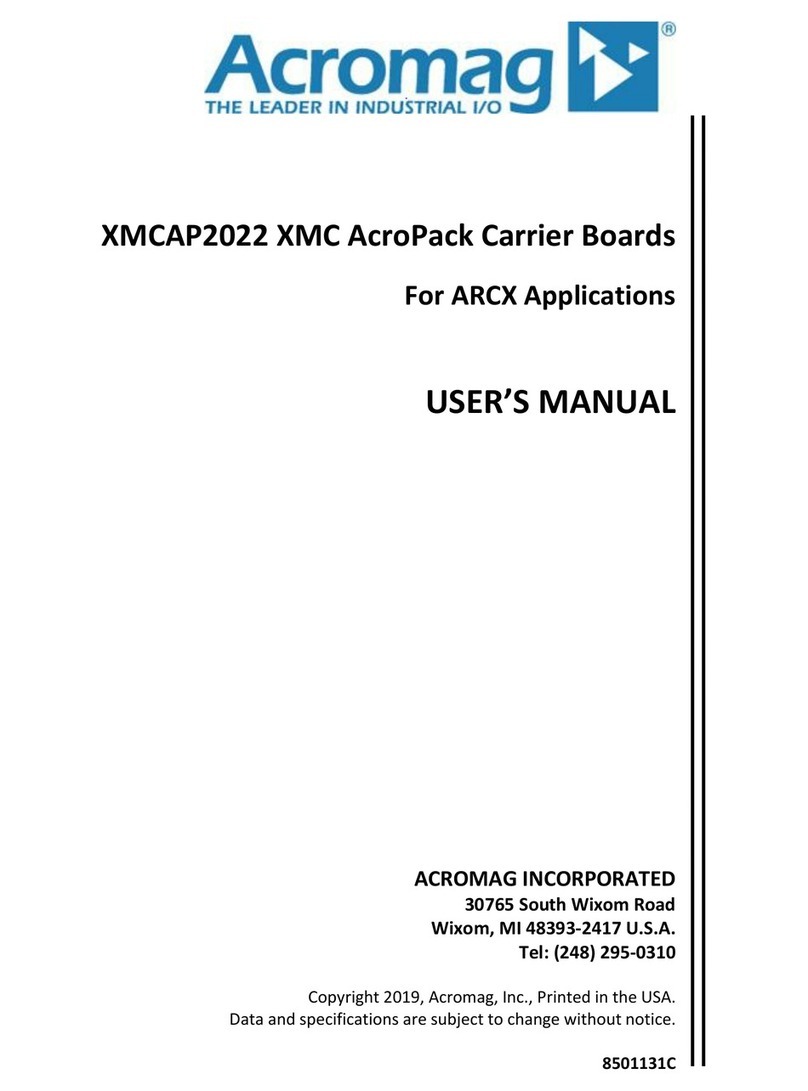
Acromag
Acromag XMCAP2022 User manual

Acromag
Acromag APC8620 Series User manual
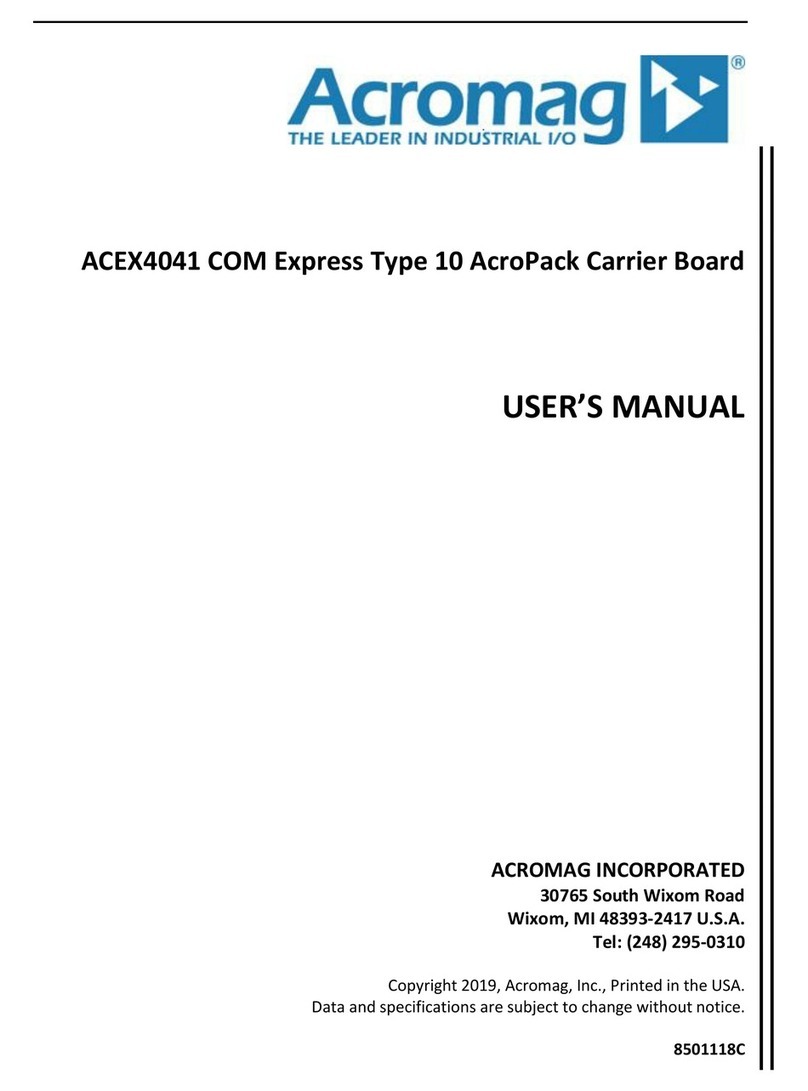
Acromag
Acromag ACEX4041 User manual
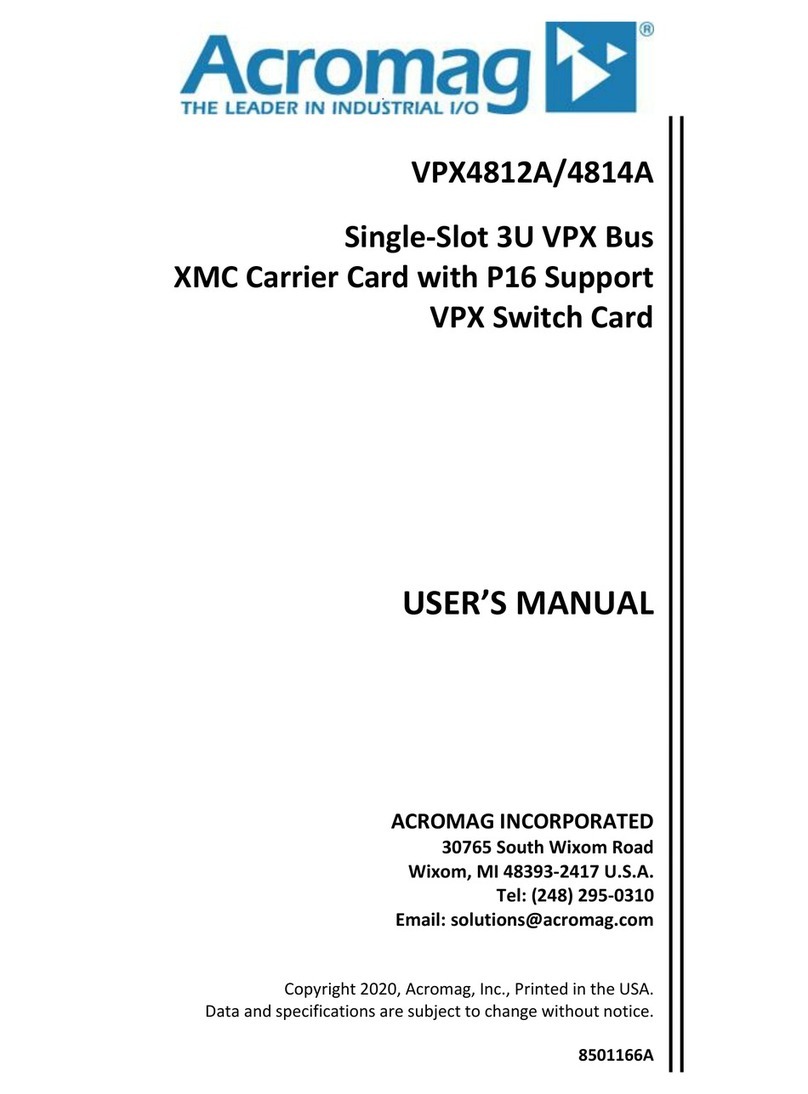
Acromag
Acromag VPX4812A User manual
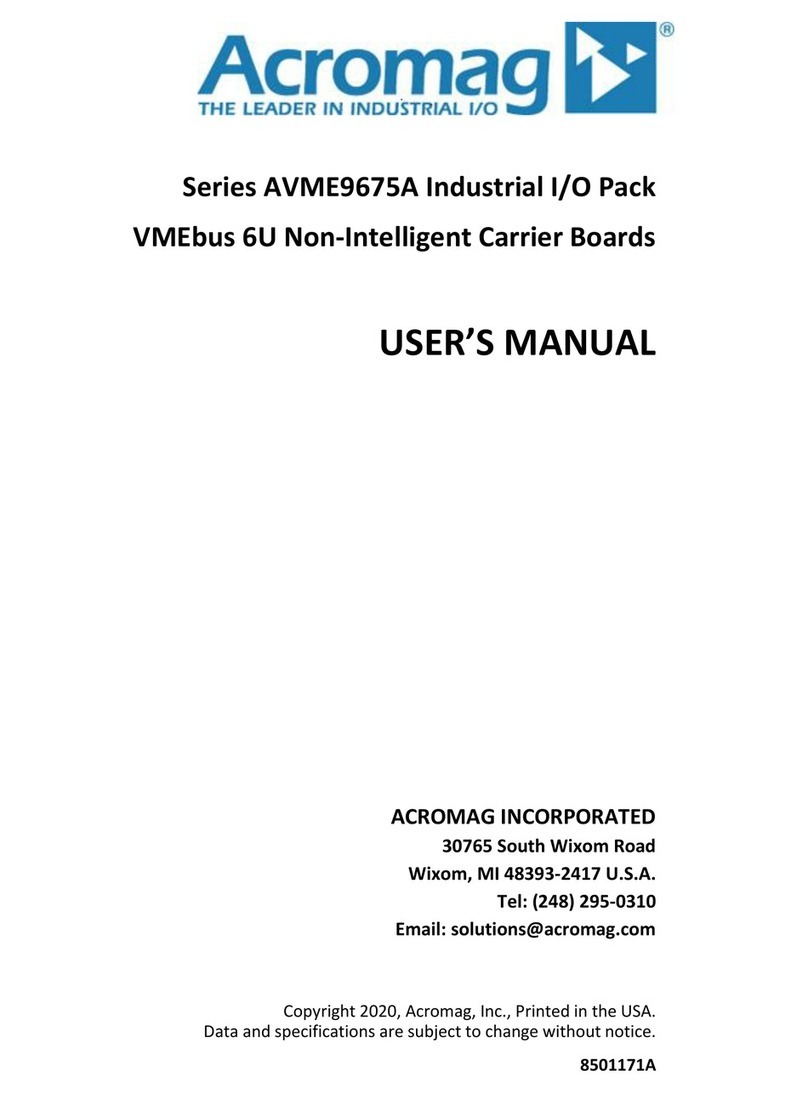
Acromag
Acromag AVME9675A Series User manual
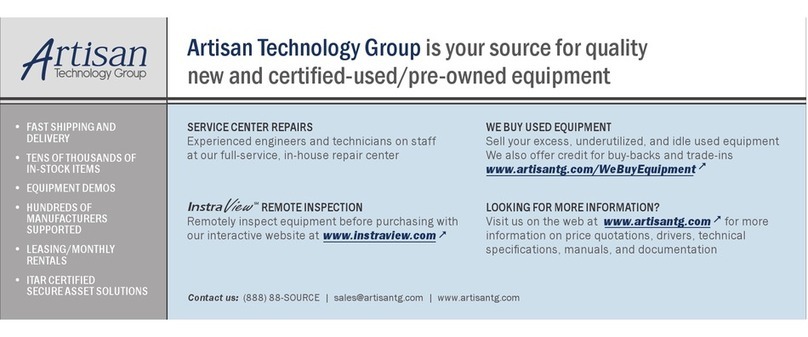
Acromag
Acromag ACPC4610E/CC User manual
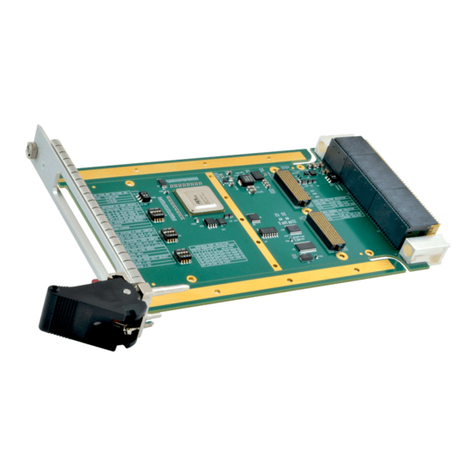
Acromag
Acromag VPX4812 User manual
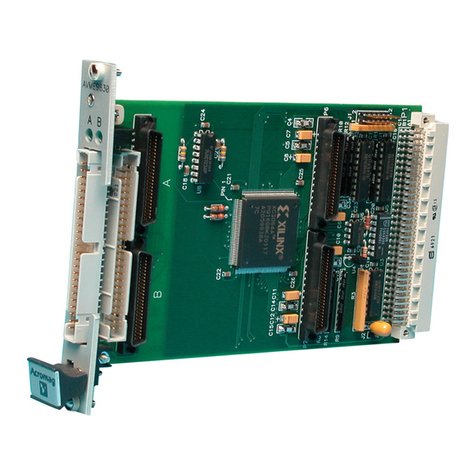
Acromag
Acromag AVME9630 Series User manual
